
INSIDE: FEATURES | COMPETITIONS | KICKS FOR KIDS | RECIPES VOLUME 10 a family lifestyle magazine TM September 2023 | R39.90 Incl. VAT Other Countries R34.70 9772311546706 23021 40+ and pregnant Pros of probiotics 8 for adapting to change tips through the ages Skincare WEIGHT LOSS Achieving healthy COVER FEATURE A BEAUTIFUL JOURNEY OF MARRIAGE & MOTHERHOOD Unpacking Do fathers matter? Greteli de Swart Iron Deficiency in pregnancy www.babysandbeyond.co.za HAY FEVER Croup in children
Feeding accessories & bibs | Clothing, shoes & socks | Nappies & wipes
























Towels & cloths | Nappy bags | Baby toiletries | Baby food & snacks | Toys & plushies



































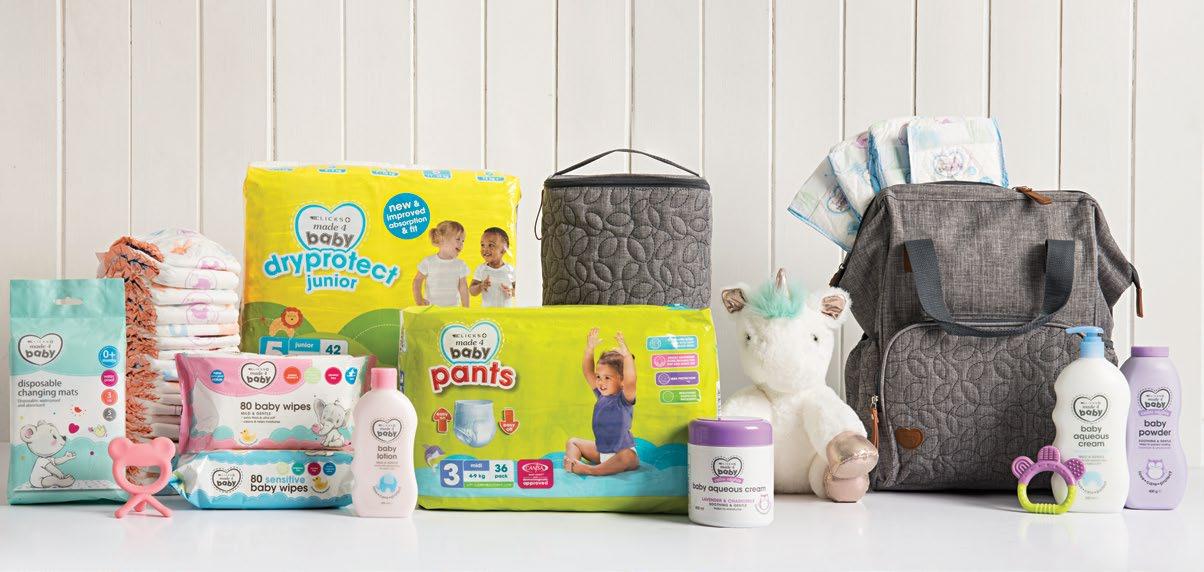
Clicks Made 4 Baby clothing is specially designed with the softest, breathable materials to ensure your baby’s comfort






made for baby’s growing bodies...
Dry, comfy nappies for a sound night’s sleep and an active playful day.
wetness indicator

dermatologically approved

































highly absorbent core








Did you know that 1 in 3 moms buy the Clicks Made 4 Baby nappy?*


























Clicks Made4Baby nappies offer superior quality at exceptional value. The highly absorbent core with leak guard protection locks in moisture for a dry, happy baby. The stretchy waist band, elasticated leg cuffs and ultra-soft back sheet ensures baby has a comfortable t all round.






For added convenience, the Clicks Made 4 Baby nappies have resealable adhesive tapes and a special wetness indicator that will assist when nappy changes are required. Rest assured that your baby’s skin is our number one priority. This nappy has been dermatologically tested and CANSA endorsed for skin safety.




No wonder 1 in 3 moms who shop at Clicks buy the Clicks Made 4 Baby nappy.








Get


*based on Clicks sales data
shop the widest range of mom & baby products available in store and online deliver we















scan the QR code to shop
now
Available in a trial pack and sizes 1 – 6
trusted quality and great value on all Clicks-brand products
STAND A CHANCE TO WIN A
House of Zinplex hamper

Includes a Zinplex Junior magnesium syrup, multivite gummies, immune booster gummies, probiotic drops, baby bum spray, Calvit K-2, baby glycerine bar, triple plus veggie caps valued at R700!

To ENTER scan the QR code with your phone and complete the entry form online at www.babysandbeyond.co.za/competitions/ Closing date: 30 November 2023. T&Cs apply.
Win!
ed'swelcome
It’s time to spring into action – hibernation is over and families are heading out and about.
While this season brings with it a kaleidosope of colours and adventures, the sniffles continue somewhat. Check out the article entitled Unpacking hay fever on page 42 for some insights. There is also an interesting read on nasal hygiene on page 44.

Sticking with the spring theme, for parents looking to keep the young ones entertained (or themselves), there is the DIY article on page 96 that shows you how to paint with flowers.
Keeping fit and healthy all year round is the goal. But, that is easier said than done. The reality is that many of us tend to let the winter season get the best of us resulting in some extra kgs. The article Achieving healthy weight loss on page 64 highlights some tips on sustainable weight loss and healthy living.
On the other spectrum, while spring is seen as a fun time, we also have to acknowledge that many people continue to face challenging situations. It could be a loss one is dealing with (see page 70), or change. Change over the past few years has been something we have all had to get accustomed to. The thing about change is that while some are comfortable with it, many struggle. The article on page 74 provides some insights on how to deal with change.
STAND A CHANCE TO WIN A

As per usual our mag is filled with interesting articles on health, beauty and features to keep you in the loop...
HE OR SHE BOTTLE SET white
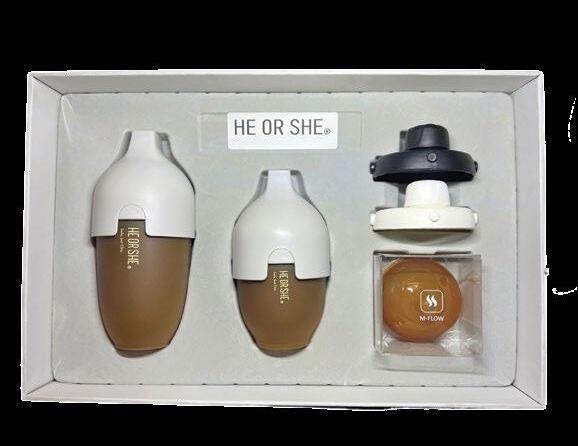
grey in colour
Includes Ultra Wide Neck Baby Bottle 240ml, Ultra Wide Neck Baby Bottle 160ml, 2 x Ultra Wide Neck Baby Bottle Transform Cap, 1 x M-Flow Replacement Nipple valued at R1 350!
To ENTER scan the QR code with your phone and complete the entry form online at www.babysandbeyond.co.za/competitions/ Closing date: 30 November 2023. T&Cs apply.


Also in this edition we have some absolutely fabulous competitions up for grabs for babies, kids and adults!
Enjoy the sun, flowers and being with family/friends!
Tashne
(or)
24-hour emergency unit
Bariatric surgery (weight management clinic)

Cardio thoracic surgery
Colorectal surgery
Dermatology
Diabetes management




Endocrinology
ENT surgery
Fertility (reproductive medicine)



Gastro intestinal surgery
General surgery
Gynaecology
Hepatobiliary surgery
Internal medicine Maxillofacial surgery
Neonatal high care

Neonatal intensive care

Nephrology
Neurology
Neurosurgery
Obstetrics
Ophthalmology
Orthopaedic surgery
Paediatrics
Paediatric high care and intensive care
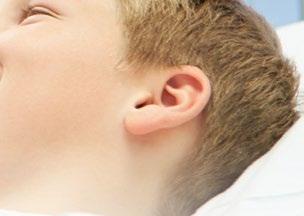




Paediatric surgery
Plastic and reconstructive surgery
Psychology
Pulmonology
Renal Dialysis Unit
Robotic surgery

Surgical and medical high care and intensive care

Multidisciplinary stroke team
Thoracic surgery
Urology
Vascular surgery
with the following services: Caring for our community Life Kingsbury Hospital Wilderness Road, Claremont, 7700 | Tel: 021 670 4000 24-hour emergency unit: 021 670 4039 www.lifehealthcare.co.za
For hospital information and specialist contact details.
SCAN ME
HEALTH

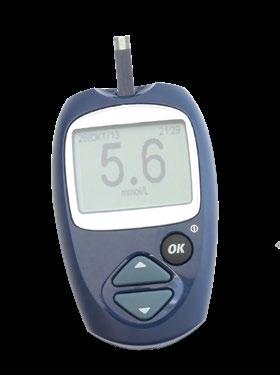





contents SEPTEMBER 2023 4 www.babysandbeyond.co.za LEAD FEATURE 16 Greteli de Swart: A beautiful journey of marriage & motherhood PREGNANCY 24 40+ and pregnant 26 Iron deficiency in pregnancy BREASTFEEDING 30 Importance of postpartum recovery for successful breastfeeding PARENTING 32 6 tips to help baby sleep at night 34 Do fathers matter? 38 Managing the teen vaping 'epidemic'
40 Aaa-choo! What happens when you sneeze? 42 Unpacking hay fever 44 How good is your nasal hygiene? 46 Hand hygiene for kids 48 Understanding eczema 50 Croup in children 54 Q&A on colic 58 Multiple Sclerosis: New disease modifying treatments 60 Untreated high cholesterol is a ticking timebomb 62 Pros of probiotics 64 Achieving healthy weight loss 16 42 8 60 22 34


Is your medical aid leaving you feeling a little blue? for a quote, or visit
babysandbeyond
PUBLISHER: Elroy van Heerden Mays elroy@mediaxpose.co.za
EDITOR: Tashne Singh editor@babysandbeyond.co.za

SUB-EDITOR: Tessa O'Hara
CONTENT MANAGER: Wadoeda Adams artwork@mediaxpose.co.za

CONTENT ASSISTANT: Ketsia Makola ketsia@mediaxpose.co.za
EDITORIAL CONTRIBUTORS
Drs Shah & Pretorius
Dr Christian Kalwiba
Taryn Paterson
Garth Japhet Mediclinic Netcare
Dr Hedi van der Watt

Dr Natanya Fourie Medipost Pharmacy
Dr Judey Pretorius
Karen Bester
Natasha Marais
Mmule Ncongwane Life is a Garden
DESIGN & LAYOUT
Shaun van Heerden Mays Anja Bramley
PROJECT MANAGER: Allison Davids allison@babysandbeyond.co.za
ADVERTISING SALES: Lorraine Beneke lorraine@babysandbeyond.co.za
DIGITAL AND SOCIAL MEDIA
Kyla van Heerden Tia Arendse
SUBSCRIPTIONS: Shihaam Gyer distribution@mediaxpose.co.za
MEDIA PARTNERSHIPS: Maurisha Niewenhuys maurisha@mediaxpose.co.za

CHIEF FINANCIAL OFFICER: Shaun van Heerden Mays
WEBSITE ADMINISTRATOR: Justin McGregor
RECEPTIONIST: Daniëla Daniels
RETAIL DISTRIBUTION: On The Dot
AIRPORT DISTRIBUTION: Media Support
PICTURE CREDIT: 123rf.com / pixabay.com

COVER & FEATURE PHOTOS: Crystal Image Productions
Van Heerden Mays Publications CC t/a Media Xpose Company Reg No: 2010/128859/23

6 Carlton Crescent, Parklands, 7441 Tel:
Email:
Disclaimer: The views expressed in this publication are not necessarily those of the publisher or its agents. While every effort has been made to ensure the accuracy of the information published, the publisher does not accept responsibility for any error or omission contained herein. Consequently, no person connected with the publication of this journal will be liable for any loss or damage sustained by any reader as a result of action following statements or opinions expressed herein. The publisher will give consideration to all material submitted, but does not take responsibility for damage or its safe return.
Credits
021 424
Fax:
3625 |
086 270 9693
Website:
info@babysandbeyond.co.za |
www.mediaxpose.co.za
ExcellenceinExposu e ExcellenceinExposu e RBG 57, 181. 74 CMYK 75,0,100,0 HEADER TEXT: NEUPOL BODY TEXT: Noto Sans Medium (Noto Sans Fonts Family)
86 NUTRITION 66 Nourishing the brains and bodies of your schoolage superstars RELATIONSHIPS 70 Learning to live without your partner MENTAL HEALTH 74 Coping with life’s curveballs – 8 tips for adapting to change SKIN 78 Skin-to-skin 82 Skincare through the ages 84 How your cycle affects EDUCATION 88 Choosing a school for your child FINANCE 90 Increased money stress Snippets – editor's choice Products – editor's choice DIY: Painting with flowers Word search Kicks for kids Book reviews REGULARS 66 96 102 SCALP 86 Yikes! My child has lice… ADVERTORIAL 94 A world-class winery by the sea

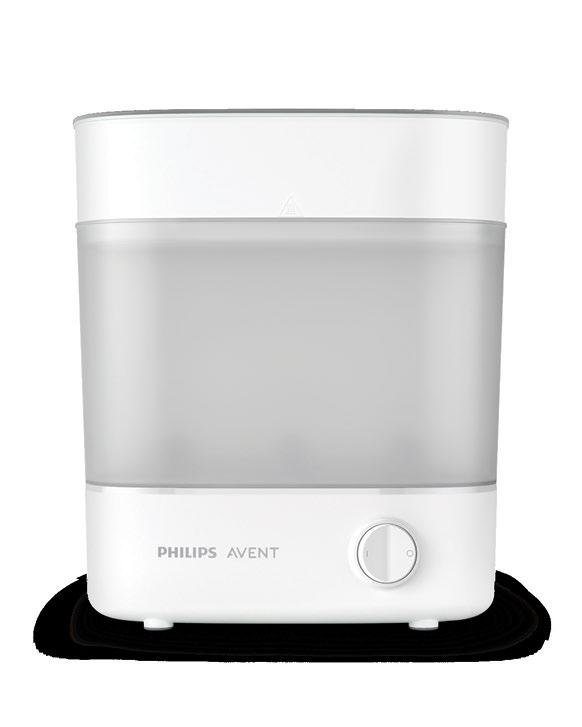



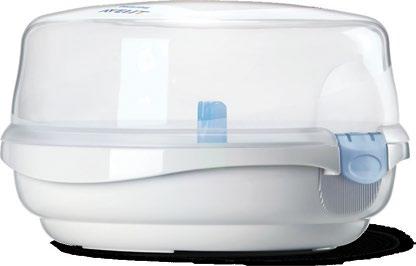


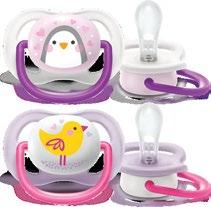

snippets - editor's choice
Travelling with kids: unlocking big adventures with Polly Pocket
Keeping little ones entertained and engaged during long journeys can sometimes be a challenge. Fear not, as there is a solution that will spark their imagination and turn any trip into a grand adventure! Enter Polly Pocket, a small toy with big potential for fun and exploration.

5 Tips for travelling with kids:
1. Pack light and smart: When travelling with kids, packing efficiently is key. Opt for compact and versatile items, and when it comes to toys that can fit into small spaces without compromising on entertainment value Polly will have you sorted. These portable playsets will keep your little ones occupied and allow you to maximise your luggage space.
2. Engage in imaginative play: Encourage your child to unleash their creativity by immersing themselves in another world. Watch as they create stories and scenarios with dolls, accessories, and settings, igniting their imagination and providing hours of entertainment. The Pocket World truly allows kids to become the directors of their own travel adventures.
Win
Stand a chance to win 1 of 2
Polly Pocket Compact Sets

Each set is comprised of three compacts to keep kids entertained!
To ENTER scan the QR code with your phone and complete the entry form online at www.babysandbeyond.co.za/competitions/

3. Enjoy screen time: Sometimes going on adventures is easier when there is a screen, so why not download episodes or clips from the animated series onto your phone or tablet? This way, they can embark on new adventures, adding another layer of excitement to their travel experience.
4. Create a travel storybook: Encourage your child to document their travel adventures by creating a travel storybook as they go on realworld adventures with Polly. They can draw pictures, write captions, or even stick photos of the two of them in different real-life travel settings. This activity not only keeps them engaged
Closing date: 30 November 2023. T&Cs apply.
but also serves as a wonderful keepsake of their journey.
5. Keep essentials handy: Remember to pack essential items like wipes, tissues, and snacks alongside the toys. These little things can come in handy during travel, ensuring a smooth journey for both kids and parents. Plus, they can double as props in the imaginative play, adding an extra layer of fun to the adventures.
Stop worms!
Did you know that one in two children may suffer from worm infestations?1 This can lead to stunted growth and mental health conditions in your children.1,2 The World Health Organisation recommends de-worming the entire family twice a year.2* Ask your pharmacist about Wormstop®, suitable for the whole family.3**

References:
1. Nxasana N, Baba K, Bhat VG and Vasaikar SD. Prevalence of Intestinal Parasites in Primary School Children of Mthatha, Eastern Cape Province, South Africa. Annals of Medical and Health Sciences Research. 2013(3):4, pgs511-516.
2. Soil-transmitted helminth infections. World Health Organisation. [online]. https://www.who.int/ news-room/fact-sheets/detail/ soil-transmitted-helminth-infections [Accessed 25 July 2019].
3. Wormstop® 100, Wormstop® 500, Wormstop® Suspension Package Insert.
*Based on an infection rate in the community that is over 50%.
**Suitable for children from 2 years and above, not indicated for animals.
SCAN NOW
8 www.babysandbeyond.co.za
Please note sets may vary.
References:






1 Iron deficiency with Iron deficiency needs to be confirmed with a blood test.
1. Mayo Clinic Staff. Iron deficiency anemia [online]. 2022, Jan 04 [cited 2022, Oct 26]. Retrieved from: URL: https://www.mayoclinic.org/diseases-conditions/iron-deficiencyanemia/symptoms-causes/syc-20355034. 2. Ning S, Zeller MP. Management of iron deficiency. Hematology Am Soc Educ Program 2019;2019(1):315-322. 3. Goddard AF, James MMW, McIntyre AS, Scott BB on behalf of the British Society of Gastroenterology. Guidelines for the management of iron deficiency anaemia. Gut 2011;60:1309-1316. 4. Short MW, Domagalski JE. Iron deficiency anemia: evaluation and management. Am Fam Physician 2013;87(2):98-104. 5. Alli N, Vaughan J, Patel M. Anaemia: Approach to diagnosis. S Afr Med J 2017;107(1):23-27. 6. Ferrimed® Impact Rx. June 2021 – June 2022. S1 Ferrimed® Syrup. Ref. No.: H842 (Act 101 of 1965). Each 5 ml contains 50 mg elemental iron as iron (III)-hydroxide polymaltose complex. S1 Ferrimed® Capsules. Ref. No.: H840 (Act 101 of 1965). Each capsule contains 50 mg elemental iron as iron (III)-hydroxide polymaltose complex and 150 μg folic acid. S1 Ferrimed® D.S. Chewable Tablets. Reg. No.: L/8.3/201. Each tablet contains 100 mg elemental iron as iron (III)-hydroxide polymaltose complex. Ferrimed® is a registered trademark of Vifor Pharma Group and is used under licence. © 2022 Aspen Group of companies or its licensor. All rights reserved. Marketed by Pharmacare Limited t/a Aspen Pharmacare. Co. Reg. No. 1898/000252/06 Healthcare Park, Woodlands Drive, Woodmead, 2191. ZAR-IFF-10-22-00004 11/2022. DON’T SUPPLEMENT
YOU NEED TO TREAT IRON DEFICIENCY 1-5 Ferrimed® Capsules: 50 mg iron & 150 µg folic acid Ferrimed® D.S. Chewable Tablets: 100 mg iron Ferrimed® Syrup: 50 mg iron / 5 ml Ferrimed - S.A.’s #1 Prescribed Iron Treatment.6
WHEN
Letibalm nose & lip repair

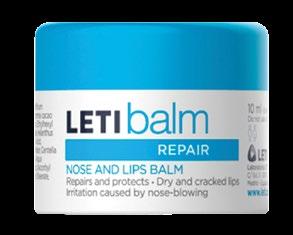

Colds, flu and allergies can result in having to blow your nose more frequently, which can leave the delicate skin around the nose and lips chapped, red and sore.
Letibalm helps protect and care for the lips, nose and the skin in-between. It gently moisturises the skin, helps repair painful cracks, soothes irritation and helps create a protective layer on the skin to prevent further chapping.
www.ivohealth.co.za
Health benefits with zinc & calamine lotion
Calamine lotion is a superb, safe lotion containing zinc oxide and zinc carbonate that has valuable anti-bacterial and anti-irritant properties, says Simon Norton, Executive Director, International Zinc Association Africa.
Its main health benefit is to relieve mild itchiness and skin irritation, for example, from contact with plants such as poison ivy, poison oak and poison sumac that can cause itching and skin irritation.
Comprising of Letibalm Nose & Repair regular balm, regular fluid and two paediatric balms.
To ENTER scan the QR code with your phone and complete the entry form online at www.babysandbeyond.co.za/ competitions/ SCAN NOW

Calamine lotion relieves the itch, along with any pain or discomfort. It also assists to dry up any oozing or weeping that can develop on your skin due to such irritation.
Other uses of calamine lotion include:
• Bug bites: Apply calamine lotion to insect bites and stings to help with mild reactions. Apply the lotion several times a day until symptoms clear up or the bug bites are gone.
• Chickenpox: Use calamine lotion to relieve the symptoms of this infectious condition. It can also prevent further skin infections.
• Shingles: Along with antiviral medicines, calamine lotion can be used for shingles. Apply the lotion directly to the skin for some relief from the symptoms of this condition.
water containing certain parasites.
• Heat rash: Calamine lotion is ideal for heat rash as well. A heat rash is an area of the skin that becomes irritated when perspiration is trapped in the pores and ducts beneath the skin.
• Scabies: A skin condition caused by small mites. To ease the itching from scabies, apply calamine lotion. Note that it can relieve the symptoms but will not get rid of the mites.
• Chigger bites: Another type of mite that feeds off human skin. Their bites can cause skin irritation and itching.
• Acne: While calamine lotion is not an acne treatment, it may help dry out pimples if used as a spot treatment.
• Hives: Calamine lotion reduces the itching caused by this skin condition.
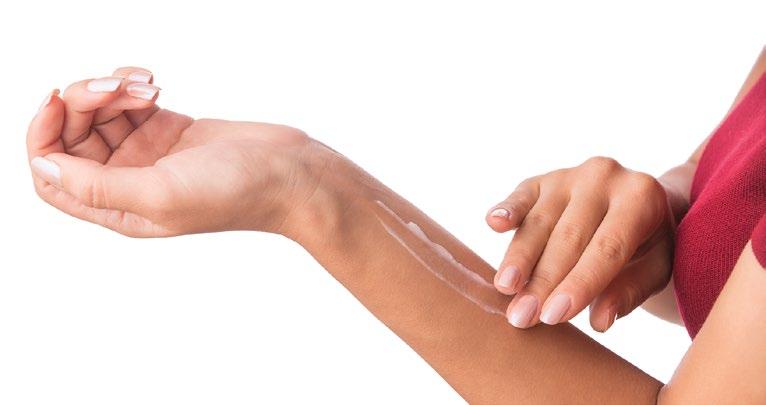
The active ingredients in calamine lotion are zinc oxide and 0.5% iron oxide, giving it a distinctive pink colour. It is an over-the-counter anti-itch medication for topical use only, meaning applied to the skin. Be sure to follow all the directions on the package or contact your doctor or pharmacist for further information.
Closing date: 30 November 2023. T&Cs apply.
• Swimmer’s itch: Calamine lotion can be used for rashes like swimmer’s itch, a skin condition that develops if you swim in
Apart from calamine lotion, zinc is a mineral that is essential for many of the body’s normal functions and systems, including the immune system, wound healing, blood clotting, thyroid function, and the senses of taste and smell. Zinc also supports normal growth and development during pregnancy, childhood, and adolescence.
www.zinc.org
10 www.babysandbeyond.co.za
Letibalm hamper
a chance to win a
Stand
Win
snippets - editor's choice



The timeless elixir: petroleum jelly
“Petroleum jelly’s unique properties make it a reliable and safe choice for a variety of skincare needs, especially for the delicate and sensitive skin of babies,” says Themba Ndlovu, Clere Petroleum Jelly Brand Manager.
Birth kits for mums


New mums will appreciate presonalised pre-packed birth kits, which are curated to meet individual preferences and needs. Embrace the journey to motherhood with confidence and convenience by having your kit delivered at your door.
Petroleum jelly benefits
• Deep moisturisation: One of the primary benefits of petroleum jelly is its ability to lock in moisture. It forms a protective barrier on the skin, preventing trans epidermal water loss and helping to keep your baby's skin hydrated.
• Soothing nappy rash: Petroleum jelly provides a protective barrier on the skin, shielding it from moisture and irritants that contribute to nappy rash. Applying a thin layer during nappy changes can help prevent and soothe nappy rash, promoting faster healing.
• Versatility: It can be used to moisturise and protect chapped lips, soothe minor cuts and scrapes, and relieve dry and itchy skin.
• Cost-effective: A little goes a long way, making it a cost-effective choice. It also has a long shelf life. Remember to perform a patch test before applying to ensure your baby does not have any adverse reaction.
According to Mellow Mama, "Getting the right products specifically tailored to your birth can be a daunting task, especially if you’ve been in search of that answer for a while."

info@mellowmamma.com | Instagram: @MellowMammaSA
The perfect pillow
Experience ultimate comfort with the versatile all-in-one pregnancy, breastfeeding, reading, and body pillow from Mellow Mamma. Crafted for serene rest and nurturing support, its luxurious design with bendable arms offers tailored comfort, while a removable head-pillow lets you personalise it. Say goodbye to restless nights and welcome a world of blissful relaxation.

info@mellowmamma.com

Instagram: @MellowMammaSA

snippets - editor's choice
Mellow Mamma birth kit hamper Comprising of a birth kit for either a vaginal or caesarean section birth valued at R1 400-R1 500! To ENTER scan the QR code with your phone and complete the entry form online at www.babysandbeyond.co.za/competitions/ SCAN NOW Stand a chance to win a Win Closing date: 30 November 2023. T&Cs apply. Mellow Mamma 3-in-1 Pillow Stand a chance to win a 3-in-1 Pillow (Pregnancy, Breastfeeding and Reading) valued at R1 000! To ENTER scan the QR code with your phone and complete the entry form online at www.babysandbeyond.co.za/competitions/ Stand a chance to win a
Closing date: 30 November 2023. T&Cs apply. SCAN NOW Winner can also choose their own material from Mellow Mama's selection. 12 www.babysandbeyond.co.za
Win
RELIEVES STIFF AND PAINFUL JOINTS
IMPROVES THE IMMUNE SYSTEM
BENEFICIAL FOR DIABETICS
IMPROVES BLOOD CIRCULATION
BENEFICIAL TO THE CARDIOVASCULAR SYSTEM AND HIGH BLOOD PRESSURE
IMPROVES SKIN ELASTICITY
BOOSTS IMMUNE FUNCTION
IMPROVES MOOD AND CONCENTRATION
REDUCES ADD SYMPTOMS


IMPROVES BRAIN MESSAGING FUNCTION

ENCOURAGES HEALTHY SLEEP PATTERNS


FOR MORE INFORMATION AVAILABLE AT ALL PHARMACIES CONTACT:
E-MAIL: valuedlife@epweb.co.za
042 293 1278
ANTIOXIDANT
Thecleaning, healingsupplement Forthewhole family
LEGO® DUPLO® bricks are double the size of the standard-sized LEGO bricks – that’s twice the length, height and width, making them easier for little fingers to grasp, stack, connect and as they are bigger bricks, this makes it safer for toddlers to play with and have fun!
Playing with LEGO® DUPLO® bricks is a great way to help toddlers, from as young as the age of one, develop their communication, problem-solving, emotional, and cognitive skills, among many others.

Through LEGO® DUPLO® play, children develop emotional skills such as resilience, self-expression, and confidence.
Playing with LEGO® DUPLO® bricks boosts creativity, allowing children to come up with ideas and transforming them into real builds!
Through constructing LEGO® DUPLO® bricks, children learn to grasp and develop hand strength, as well as their understanding of movement and space.

LEGO® DUPLO® play encourages social skills, helping children become more collaborative and communicative.
With LEGO® DUPLO®, children are introduced to numbers, letters, shapes and colours. Children also learn how to concentrate on completing a task through the process of trial and error.
lead feature
A beautiful Greteli de Swart: journey
of marriage & motherhood
Greteli de Swardt is a South African actress, photographer, artist, and influencer known for her roles in the kykNET series Alles Malan and the Netflix series Blood & Water. Here she talks about her journey as a new mother.

16 www.babysandbeyond.co.za
You kick-started your career at a young age and have established yourself as a household name. Are you surprised at your success? Definitely surprised, but thankful for the opportunities that came my way at a young age. When I was 17 years old, I got an opportunity to play in an Afrikaans series and I realised that this is what I want to do for the rest of my life. I worked really hard to get into the industry.
The impact that Blood & Water (on Netflix) had on my career was incredible, not only from an acting perspective, but it also opened doors to grow my social media presence.
For now, I am taking a bit of a break to be a mother. I can’t really work on set because of the really intense hours – usually 12 hours a day, six days a week, and my baby is very young. I want to be here with her and watch her grow. For now, I am doing a lot of social media work.
Tell us a bit about the work you do on social media.
I didn’t realise how much people like and appreciate authenticity on Instagram. During my pregnancy I started sharing some very real and unfiltered moments, mostly quite funny moments. The amount of people that could relate was incredible.
I think since I became pregnant my audience doubled on Instagram! It started because of all the raw moments I began to share. It was so beautiful for me to see how people appreciate the honest moments. I hope to continue sharing the true journey of motherhood, including the beautiful and challenging parts to help encourage parents and young mothers.
I work with brands on social media, but I would not promote something I don’t believe in. I absolutely hate it when influencers make you believe in a product that does not work and you spend money on something that is actually a lie.
When it comes to skincare products, I always ask for the product to test it out myself before collaborating with the brand. I first chat to the people behind the brand and hear what their values are and what they would like to achieve from it, and I love to add value to a brand.
I would advise aspirant influencers to be as real as possible. That is what attracts people the most, and if you keep on being real, people will start believing you and the product you are promoting.
According to your bio, you are described as “a risk-taking young woman who married at the age of 21 and recently gave birth to her firstborn.”

I never thought I’d marry this young… never mind having a child this young. I always thought I’d live my life, do my thing and then settle down and commit. It is so sad I had that mindset, which a lot of people have, that the moment you marry or have children your life is over, and you can’t live for yourself anymore, or do stuff for yourself. This is such a lie. I feel like my life is only beginning now. I am embracing it every single day.
Things that I thought were important in my teenage years are nothing compared to what I have now. I would do it over and over again – marriage is a beautiful thing. It is hard, but so beautiful.
I definitely think there are pros and cons of being a young mother. The pro side is that it is physically easier on your body. On the other hand, I can’t always relate to people my age who are studying as we are in different phases of life. I think it is quite hard to make friends as young mother because you feel like you don’t fit in anywhere; your friends don’t understand the life and task of motherhood and I don’t understand my friends' study lives. However, I don’t feel like I lack anything as I have my husband, my baby and my small circle of friends who are all amazing… but it could be a down side for some people.
lead feature
17 www.babysandbeyond.co.za
lead feature
How do you manage to balance being a wife and mother with the demands of a thriving career?
It is hard work, but doable if you have an amazing husband like mine. The acting industry is quite a wild one as it is uncertain, and you don’t know when you are going to work again.
For example, you will have a job for three to four months and then it can be quiet for nine months or even a year without being booked for anything.
I am lucky to be married to another freelancer, so we kind of wiggle and giggle around each other. I have seasons where I work, and then my husband has seasons when he works. When he works I am a fulltime mother and housewife. When I am working, he takes over all the household tasks and tries to run the family. My husband does a lot to help me stay balanced.
Tell us a bit about your journey of pregnancy. My pregnancy was such a beautiful journey. It was relatively easy, and I was not really nauseous, nor did I have too many bad symptoms. We chose to not know the baby’s sex while I was pregnant, so it was extra exciting when she was born.
What is the highlight of motherhood for you?
I can’t pin it down. There are just too many – I feel like everything is a highlight. Even the sleepless nights are a highlight because you know it is only for a short period of time. It is a love that I never knew existed and discovering that love is really such a big highlight for me.
What do you find challenging about motherhood?
I think everything goes by at such a fast pace. You think you have one thing figured out and then the next phase comes. At the moment it is getting your baby to grow physically and making sure you give your baby the right nutrition to help them grow well.
What has been the biggest change for you since becoming a mother?
There are so many changes. The first thing I realised was I never knew my heart could love this much. Loving your husband is a different type of love. Your friends and family share a different type of love, but loving a baby and the innocence of a child makes it so incredible. I wasn’t fond of children that much but loving your own is life changing.
What are your key values that were passed onto you that you want to pass on to your daughter?
I think in today’s world it is so hard to raise a child in terms of morals and values. I am scared to allow my baby to step into this world without being by her side at all times and being there to help her make good decisions. I think the parenting and teaching part will have to kick in sooner rather than later.
I am so grateful that I come from a home where my parents raised me intentionally in terms of moral and values. I would love to pass on everything I have learned from them, especially my faith. We are lovers of God, and I would love to teach our daughter that faith is an important part of life.

18 www.babysandbeyond.co.za
What would you say is key to a successful marriage?
I don’t think there is a one key or tip that would make a marriage successful. What helps us is to always check in on each other and to make sure on what page the other one is on.
Whenever my husband comes home or vice versa, I usually ask him, or we would ask each other “on what level are you? Are you a 5/10 or a 2/10?” If he says he is a 2/10 and I am a 6/10 then I know I must take the lead that night. I run the house and sort out the food. I help wherever I can to make his life easier. I don’t believe marriage is 50/50. I believe the one helps the other one up to a 10. This method works for us.
What does the future hold for the de Swart family?
I have absolutely no idea! Our life is changing so fast, but we are taking it day by day and always grab opportunities when they appear. We would love to start exploring and go overseas quite early with our baby girl to show her the world, and continue to work hard as a family.
What was the most exciting part of pregnancy from a male perspective?
During the pregnancy it was an incredible journey with my wife. I was a bit scared in the beginning because I grew up in a house full of men, went to a boys school, lived in a boys residence, and worked in an environment dominated by men, so I knew nothing about pregnancy.

There are so many opportunities for a husband to be there for his pregnant wife, like when she gets uncomfortable or emotional, especially with hormones being all over the place. You have that moment to calm her down and help her out.
Pregnancy brought us close, and it did our marriage a lot of good because it is a team exercise and I really enjoyed being part of it.
I gained a lot of respect for my wife, seeing what her body went through. She is very insecure about the way her body changed, but I liked the changes and if it wasn’t for these changes, we wouldn’t have our beautiful daughter.
Since the birth of your daughter, do you think you have changed as an individual and husband?
Yes, of course! To sum it up in a way most people would understand: academics took away a lot of my passion and drive for life. It feels like everything that academics stole out of my life, the baby gave back to me. I feel I am unstoppable, and I wake up in the morning with drive for my family, and I can’t help to be inspired and man-up for the role.
Favourite movie: JoJo Rabbit
Favourite series: Grey’s Anatomy
Favourite food: Pizza
Favourite place: Tergniet
Guilty pleasure: Ricoffy
What is the most exciting part of being a father?
We play for probably a total of two hours a day, not because it is prescribed but just because I want to. In a nutshell, seeing her smiles and joy when I play with her makes me feel like a fun dad and I love that part.
Greteli’s husband chats from a male perspective
Juan de Swart
lead feature
Snap shot with Greteli de Swardt
19 www.babysandbeyond.co.za
I don’t believe marriage is 50/50. I believe the one helps the other one up to a 10.


Shop babywear instore and Superbalist.com
EDITOR'S TOP PICKS Beauty . Health . Baby
Kids Elderberry Support Liquid

Offers immune support and tastes great. It combines elderberry concentrate with zinc to promote seasonal wellness and daily maintenance of health and well-being that the kids will love. It features Astragalus, a herbal ingredient, that has been included to support a healthy immune system response to seasonal challenges.
www.dsinternational.co.za
LEGO DUPLO Organic Garden
This set is packed full of features to help parents spark conversations about what grows in the garden and introduces kids to the idea of an ecosystem. There’s plenty for little fingers to explore, including tomato, carrot and watermelon toys, trees, flowers, wildlife and weather bricks. www.lego.com/en-za
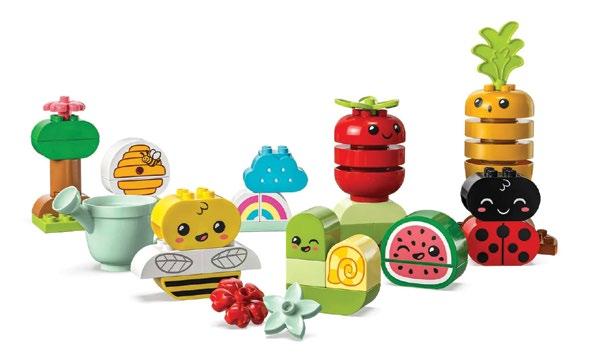
HASK Sensitive Care Fragrance Free Shampoo

A hypoallergenic, dermatologistapproved shampoo that gently cleanses to remove impurities, product build-up and environmental pollutants without fragrance or essential oils. Formulated with a blend of oat extract and pro-vitamin B5 to help protect and moisturise for healthy-looking hair and happy-feeling skin.
www.haskbeauty.com
Tree Hut’s Shea Sugar Scrubs

Transforms your exfoliation routine into an indulgent self-care ritual thanks to the luxurious formulations and scents. Tree Hut scrubs contain sugar crystals which are gentler on the skin so you can remove dead skin cells safely, without damaging your skin. The scrubs are available in many different variants.
www.medhealthsup.com
Earthsap Orange & Mandarin Foam Bath

This all-natural, SLS-free bubble bath cares for skin while you soak. Its biodegradable formula offers a fresh, uplifting citrus fragrance you’ll adore.
www.faithful-to-nature.co.za
Wormstop® STOPS worms…

An effective and affordable treatment to eradicate most intestinal worms, suitable for the whole family. Available at pharmacies.
www.sunpharma.com
products - editor's choice
1 6
3
2
4 5
22 www.babysandbeyond.co.za
Vital
Baby®
NURTURE™ flexcone™
This manual breast pump with its unique super soft silicone breast cup and flexcone™ massages the breast by gently mimicking the natural suckling action of your baby to provide the most natural and effective experience.
www.vitalbabyshop.co.za
NutriPure MultiVitamin Complete Packed with 12 essential vitamins and minerals: Vitamin D, B6, B12, C, Biotin, Pantothenic Acid and Niacin, helps to metabolise carbohydrates, fats, and proteins, all factors in the maintenance of good health.

www.nutripure.co.za
Vital Baby NOURISH Prep & Wean™
Steam cook and blend healthy homemade meals quickly for your little one. The simple and easy to use Prep & Wean™ has three distinct functions and a large 900ml jug capacity to help you through every step of weaning – sterilising, steaming, and blending. www.vitalbabyshop.co.za


Vital Baby SOOTHE Airflow Soothers, 0-6months

Vital Baby symmetrical soother teats make the soother easy for baby to hold in their mouth. 100% soft silicone is taste and odour-free and comfortable for baby. The wide-open Airflow shield helps to protect delicate cheeks against skin irritation. The simple safety ring folds neatly and inconspicuously against the soother. Comes with a microwave steriliser box for easy sterilising and storing. www.vitalbabyshop.co.za
NOW® Probiotic-10™ for adults offers a balanced spectrum of live organisms consisting of acid-resistant probiotic bacterial strains that are known to naturally colonize the human GI tract.
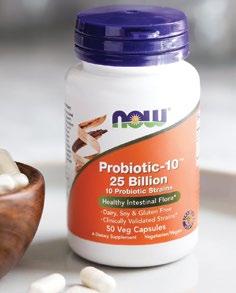
Probiotic bacteria are critical for healthy digestion, helping to maintain the integrity of your intestinal lining, and support proper intestinal motility and detoxification.
Probiotic-10™ utilises bacterial strains that have been clinically validated for their support of healthy immune system function. www.dsinternational.co.za
OGX Argan Oil of Morocco Lightweight Shampoo
For weightless cleansing and hydration.Designed for fine hair, this lightweight shampoo is infused with Argan and Vitamin B5 to help cleanse and hydrate your hair, without weighing it down. The salonquality, sulfate-free blend will help leave your hair feeling healthier, nourished, smooth and up to 5 x stronger in just two washes.

products - editor's choice
7
8
9 10
12
11
23 www.babysandbeyond.co.za
“I feel so stressed about my pregnancy! What if something goes wrong? I am not young anymore. Will my baby be ok? What risks are there?” These are questions that gynaecologists face every day. And the answers to these questions are not always straight forward.
 By Drs Shah & Pretorius
By Drs Shah & Pretorius
40+
pregnancy
24 www.babysandbeyond.co.za
pregnant and
our pregnancy journey should be a very exciting time in your life. But it can be a very daunting time, especially if you are older. Data from the USA confirms that the average age when women have their first baby, continues to increase.
Women are more career oriented and therefore tend to delay pregnancy and parenthood. Other reasons for delaying pregnancy include effective contraception, gender equity, economic uncertainty and absence of supportive family structures.
A woman’s peak reproductive years are between late teens and late 20s. By the age of 30, the ability to conceive starts to decline; this decline becomes more rapid once you have reached mid-30s. Although it is not impossible to conceive above the age of 40, it does get more difficult.
Any pregnancy in women above the age of 35 is considered a high risk pregnancy. These pregnancies are at risk of potential complications. The most common complications are miscarriages, development of pre-eclampsia (high blood pressure and protein in urine), diabetes, as well as premature labour and birth, and stillbirths. It is important to note that your pregnancy will be closely monitored throughout for the development of complications.
Expect growth scans
In the second trimester, a detailed anatomy ultrasound (between 18-22 weeks) of your baby will be done to detect potential physical abnormalities. By 20 weeks, your baby has formed, and he/she should just grow from there. The detailed anatomy scan assess baby from top-to-toe to ensure normal development of their organs.

A glucose test will be performed to exclude diabetes of pregnancy. Diabetes of pregnancy is more prevalent in older patients, and it is important to exclude this, to minimise the risk of a stillbirth. If it is present, this will be managed and monitored carefully.
Expect close foetal surveillance
You can expect more frequent visits during your pregnancy as well as close foetal surveillance (with ultrasound). During the first trimester, your gynaecologist will discuss potential chromosomal (genetic) abnormalities with you.
All women begin life with a fixed number of oocytes (eggs) in their ovaries. The number of oocytes decreases with age and are also more likely to have abnormal chromosomes. Certain tests can be offered (blood tests and a 12 week ultrasound) that can be done to assess the risk of a chromosomal/genetic abnormality. These tests involve screening tests (assess the risks that a pregnancy is affected) and diagnostic tests (can detect if a pregnancy is affected). The most common chromosomal abnormality is Trisomy 21 or Down Syndrome. Testing for Down Syndrome can be offered, and these tests have a 99,9% accuracy.
You will also have more growth scans, to ensure that your baby’s growth and development is adequate.
You will be counselled on what symptoms you should be on the lookout for, eg. foetal movements, bleeding, severe headaches and blurry vision.
Your pregnancy and delivery of your baby should always be one of the best times of your life. With advanced technology and tests, your pregnancy should result in a healthy mother, giving birth to a healthy newborn baby.
Drs Shah & Pretorius are both very passionate about women's health and they are situated at Netcare Blaauwberg Hospital in Cape Town, South Africa. Both are specialist Obstetricians and Gynaecologists with special interest in pregnancy, female fertility and are dedicated to supporting women achieve optimal health.
www.blouberggynaecologist.co.za
pregnancy
Y1 2 25 www.babysandbeyond.co.za
Iron deficiency
in pregnancy

Iron is one of the most important nutrients for human beings. Not only is it a key player in red blood cell synthesis and erythrocytes production, but it also plays a role in multiple physiological processes including oxygen transport to different parts of the body, protein synthesis and cellular respiration.
By Dr Christian Kalwiba, Obstetrician Gynaecologist
pregnancy
26 www.babysandbeyond.co.za
Pregnant women are especially predisposed to iron deficiency because of the different physiological changes happening during pregnancy.
Firstly, the number of red blood cells in the body and progressive blood dilution due to increased plasma leads to a decrease in iron concentration. This process happens from conception until week 35 in pregnancy.
Secondly, iron deficiency is ascribed to the increasing demand in pregnancy due to fetal development and growth, with the placenta requiring high iron for the exchange between mother and fetus. The demand is greater in a multiple than a singleton pregnancy.
In addition to the above normal physiological changes that predispose pregnant women to develop iron deficiency in pregnancy, there are other risk factors which further increase the chance of this condition. These include having two pregnancies close to each other, being pregnant with more than one baby, iron-poor nutrition, nausea and vomiting due to severe morning sickness, heavy pre-pregnancy menstrual flow, and anemia before pregnancy.

A lack of iron will lead to either one of two different medical conditions:
Iron deficiency with anemia, commonly known as iron deficiency anemia, which was for a long time considered to be the only manifestation of lack of iron; or
Iron deficiency without anemia, also called iron deficiency.
These two conditions are not synonymous. In a nutshell, iron deficiency is a state of negative balance where the iron supply does not meet the demand, whereas iron deficiency anemia constitutes a low hemoglobin level due to a lack of iron resulting in poor production of red blood cells. Laboratory tests help differentiate between these two conditions.
pregnancy
27 www.babysandbeyond.co.za
Symptoms of iron deficiency or iron deficiency anemia
The symptoms of both iron deficiency and iron deficiency anemia are fatigue, weakness, dizziness, headache and craving or chewing ice (Pica).
You will notice that these symptoms are also present in pregnancies with iron sufficiency. Even though pregnant women are screened for anemia in pregnancy worldwide, I believe that we should also add the screening to our routine blood test in pregnancy.
Assessing the iron levels at that stage will help us make an early diagnosis of iron deficiency or iron deficiency anemia. In this way, these conditions can be treated before the unborn baby is negatively impacted.
Crucial to maintain ironsufficient state during entire pregnancy
It is crucial to maintain an iron-sufficient state during the entire pregnancy to avoid short- and long-term effects on the unborn baby. The immediate consequences of lack of iron are the increased risk of a pregnant woman having a small baby, and high-risk prematurity (delivery of baby before 37 weeks).
Lack of iron is also associated with postpartum depression and a low iron level in the newborn, in other words the newborn will also suffer from iron deficiency.
Recent research has revealed that low maternal iron in the last trimester of pregnancy results in altered brain structure and affects neurocognitive function. Even if the
deficiency is later corrected in the infant, low neonatal iron status results in reduced recognition memory performance at age 3-4 years. According to some publications, iron deficiency may also be associated with depression, anxiety, and social dysfunction later in life.
Preventing iron deficiency

Lack of iron during pregnancy can be prevented by different means such as good nutrition, including the consumption of iron-rich food like lean red meat, poultry and fish.
Prenatal vitamin supplements all contain iron, and this can be used as a
Dr Christian Kalwiba
preventative measure in women where iron levels are not yet low, or as curative measures where the iron concentration in the blood is below the lower limit of normal. It is recommended that, to prevent iron deficiency, all pregnant women should receive prenatal vitamins containing iron.
In some circumstances, depending on the severity of the iron deficiency or if the pregnant woman is unable to take iron tables orally or has severe nausea and vomiting, intravenous iron (iron in the drip) can be given in order to the correct the iron levels. This, however, can only be done in hospital.
MD (DRC) DIP OBST (SA) FCOG (SA), MMED O&G (UCT) FMAS (INDIA)
Dr Christian Kalwiba is a highly skilled obstetrician and gynaecologist who delivers comprehensive medical care, and ensures his patients are well-informed about their medical condition(s). He is particularly interested in gynaecology and promotes a natural, vaginal birth.
Address: Kingsbury Medical Suites, Wilderness Road, Claremont, 7700 Tel: +27 (0)21 745 6565 | Email: reception@drkalwibaobgyn.co.za
www.drkalwibaobgyn.co.za
pregnancy
28 www.babysandbeyond.co.za

Importance of postpartum recovery
breastfeeding for successful breastfeeding
Breastfeeding is a natural and essential way to nourish and bond with a newborn baby, yet this is often a challenge for new mothers.
Postpartum recovery, the physical and emotional process of healing after childbirth, is not often spoken about, but it is hugely important for both the physical and emotional health of new mothers. Many new mothers face challenges in establishing and maintaining successful breastfeeding due to a lack of postpartum recovery support and education.
Lizeth Kruger, Dis-Chem Baby City’s National Clinic Executive, shines the spotlight on the importance of postpartum recovery education and its impact on breastfeeding outcomes. She offers the following guidelines which contribute to a positive breastfeeding experience.

30 www.babysandbeyond.co.za
Physical and pain recovery
Rest, rest, rest. Fatigue is real. New mothers should not be afraid to ask for help from family and friends. Physical recovery is hugely important as it can take several weeks or months for a woman's body to fully recover from childbirth.
Physical pain is also a reality from the process of birthing a baby including stitches or a caesarean section operation which adds to discomfort for mothers. Medication for pain management is therefore important. Coupled with good nutrition and rest, this increases breastfeeding success.
Emotional support
Equally important is emotional well-being which plays a significant role in breastfeeding. Supportive partners, family members and healthcare providers can offer emotional support, encouragement, and reassurance, which help alleviate stress and anxiety, creating a conducive environment for successful breastfeeding.


Mothers who are well-rested and nourished are more likely to have more energy to produce an ample milk supply and effectively breastfeed their infants. Well-informed mothers are more likely to approach breastfeeding with confidence and have a higher chance of success.
Building confidence
Postpartum recovery support and education help instil confidence in new mothers, empowering them to overcome breastfeeding challenges. Mothers who feel wellsupported and knowledgeable, are more likely to persist with breastfeeding and navigate difficulties successfully.
Healthcare professionals play a vital role in postpartum recovery support and education by providing personalised guidance, addressing concerns, offering practical tips and referring mothers to additional resources as needed.
New mums especially do not always get latching and breastfeeding techniques the first time. Be patient with yourself and your baby. If milk supply is challenging, get in touch with your doctor or nurse at your healthcare clinic for assistance.
Remember you are not a failure and that it is not your fault if baby is fussy and not feeding. Help is always on hand and most nurses are well equipped to assist with breastfeeding, post-partum recovery, proper nutrition, hydration, and sleep hygiene, which all contributes to overall well-being and optimal milk production.
By prioritising comprehensive postpartum support and education, healthcare professionals significantly enhance breastfeeding outcomes.
Especially for the
WORLD’S GREATEST MOTHERS
When mothers prioritise their own well-being, they can establish and maintain a healthy milk supply, ensuring their infants receive sufficient nourishment contributing to prolonged breastfeeding. Mothers who receive the necessary support and education are more likely to breastfeed exclusively and continue breastfeeding for the recommended duration, providing their infants with optimal health benefits.
www.carriwell.co.za
breastfeeding
Healthcare professionals, a helping hand
baby sleep at night 6 tips to help
A baby who struggles with sleep is never easy for parents...
By Taryn Paterson
“Over exhaustion, for both baby and parents, plus being new to having a child, can create anxiety when it comes to babies who do not sleep well,” explains Bronwyn Ragavan, Brand Manager for Karvol.

“It can leave many parents feeling as though they are not able to cope. Having children, whether it is your first or last, comes with a learning curve, and the best place to start is to first eliminate why the child is not sleeping.”
The most common reasons and possible solutions
When a baby is uncomfortable due to reasons such as a wet or soiled diaper, feeling too hot or cold, or being in an uncomfortable sleeping position this can affect their sleep, and should be addressed before falling asleep. Decongestion can also create discomfort and keep a baby up and miserable. Dropping Karvol onto baby’s pillow at night will help with the decongestion and allow them to have a better night’s sleep. The trusted Karvol formula includes a combination of aromatic oils such as eucalyptus and menthol that when dropped on baby’s pillow or a handkerchief and inhaled helps them to breathe easily. (Ed's Note: Please read information leaflet such as age restriction etc. prior to using Karvol.)
Babies can develop associations between certain actions or objects and falling asleep, such as being rocked or using a pacifier. If they wake up during the night and these associations are not present, they may have trouble falling back asleep. You can try reducing their dependency on these items by slowly withdrawing them once your baby is drowsy but awake, helping them to learn that they can fall asleep without assistance.
4 5 6
Before bedtime, try to limit the amount of stimulation your baby experiences. Babies can become overstimulated from their surroundings, which can make it difficult for them to settle down and sleep. Creating a calming bedtime routine in a soothing environment can help baby relax. This can include a warm bath, a lullaby, and a story. A warm, dimly lit room is the perfect setting for baby.
1 Babies have small stomachs and need to eat frequently, especially during the early months. If a baby is waking up frequently and showing signs of hunger, they may need to be fed more often or have larger feeds before bedtime to reduce the likelihood of hunger interrupting their sleep. 2 3
It is important to know that babies often go through sleep regressions, which are temporary periods when their sleep patterns are disrupted. These regressions can occur around developmental milestones, teething, or changes in routine. Patience and consistent bedtime routines can help them adjust during these phases.
If a baby is unwell or experiencing discomfort due to teething, colic, or other health issues, it can disrupt their sleep patterns. Consulting with a paediatrician can help determine if there's an underlying issue that needs to be addressed.
The challenges of a baby not sleeping at night can take its toll on the parents, leaving them feeling exhausted and overwhelmed.
“It is essential to remember that this phase is temporary and part of a child's natural development. By understanding the different factors that can disrupt a baby's sleep and by finding ways to overcome them, parents can create a nurturing environment that promotes better sleep habits over time. Remember, every baby is unique, and finding the right solutions may take time, but with dedication it can be achieved” comments Ragavan.
parenting
32 www.babysandbeyond.co.za





Do fathers
matter?
By Garth Japhet, CEO of Heartlines

In the 30 years that I’ve been involved in addressing some of our region’s most pressing health and social issues, including GBV, HIV/AIDS and child abuse, I have never encountered an issue that is as emotionally charged and resonant – with as many people across all sectors of our society – as fatherhood.

parenting
34 www.babysandbeyond.co.za
For some people, it’s been gratitude for how much their dad’s positive and active presence has shaped their lives. For many more, it’s been about the negative effect his absence has had. For others, he may have been present, but this “presence” has been more a curse than a blessing. There’s the “hide and seek” dad (now you see him, now you don’t); the “ATM” dad, who is present with his money but not his time; the “fly on the wall” dad, who’s physically present but emotionally absent; and the abusive dad, who’s emotionally and/or physically abusive.
Whatever people’s experience of their dads, for most of us, his influence is profound. How he does or does not show up matters to us. But is this just an emotional issue? Does his presence or absence really make any difference to our lives? It turns out that it does.
Children are more vulnerable without a strong father figure Local and international research has shown that not having a present father figure increases the risk of children being victims of violence and, when they grow up, becoming perpetrators of violence, including GBV.
In the US, over 90% of men in prison for violent crimes come from father-absent homes. Anecdotally, the same is true here. Children are also at greater risk of substance abuse, mental illness, and poor educational and economic outcomes if they don’t have strong father figures at home.
Greater risk does not mean a life sentence. In the same way that smoking doesn’t automatically mean someone will get cancer, children from father-absent homes don’t necessarily end up with these problems.
In fact, many single mothers do an amazing job of raising balanced, productive, and happy children. But single parenting often comes at great personal cost, which could be reduced by having more active, present fathers or father figures.
Over 60% of SA children growing up without a biological father in their lives
While I was aware that this was an issue, it was only when we started our research that I realised just how big an issue it really is. It’s astounding that over 60% of South African children are growing up without a biological father in their lives. It’s one of the highest rates in the world.
This, I believe, is a public health emergency as it contributes to many of our most pressing social issues. Surely, we should be tackling it with the same vigour that we did HIV and Aids and Covid?
The good news is that it is eminently possible to inspire and support many more fathers and father figures to be active, positive and present in children’s lives and, in so doing, yield real long-term benefits for our society.
Why are men not present?
The first step is to understand the problem. Why are men not present? Is the popular narrative of “the deadbeat dad” true? In 2019, Heartlines conducted the largest research study of its kind to find the answers and they were surprising.
While absence can be attributed to a number of complex factors, it appears that most men really want to be present but face significant barriers.
By far the biggest is the perception that a father’s role is to provide financially. If you can’t provide, then you can’t be in the child’s life. This is a deeply entrenched belief that is as much held by men as by women.
A quote from a woman in one of our focus groups illustrates this: “If he can’t bring money into this home, I don’t need another child in the house.” The lack of money is also a barrier in some cultures where payment is expected for "damages" for children conceived out of wedlock and for lobola. If this is not paid, the father is often prevented from being present. This in the context of mass unemployment.
Unsurprisingly, money is not what children most want from their dads. They want their time, their undivided attention, their affirmation.
A further barrier is lack of skills. If you have not been fathered yourself then how do you father? Encouragingly, I have met many men who, despite not having been fathered, are determined to be the father they never had.
Relational breakdowns can also play a significant role, where children are used as cannon fodder in parental wars.
Our health system can also be a barrier. Research has shown that if a man is present in the antenatal and birth process, he is much more likely to be present in the child’s life as they grow up. However, many health facilities bar men from this process. This is combined with the perception that the birth process and subsequent care for children is “women’s work”, and men have no place in it.
But the barrier that excites me most, in that it is the simplest to address, is the lack of societal awareness as to how important it is for fathers or father figures to be present and to play an active and positive role in children’s lives.
parenting
35 www.babysandbeyond.co.za
‘Fathers Matter’ intervention is the largest of its kind in Africa
Based on this research, Heartlines has developed Fathers Matter. Since we are working with over 70 partners, it is the largest intervention of its kind in Africa. Using a combination of mass and social media as well as face-to-face programmes in faithbased organisations, workplaces, and sports clubs, we aim to change the narrative of the deadbeat dad to an understanding of why fathers really matter and what often stands in their way of being present.
Furthermore, we are inspiring and supporting men and women with what they can do to ensure that more men – whether or not they are biological fathers – are present, positive and active in children’s lives.

The Fathers Matter television series showed on SABC 2 features six short films in the series, set in different communities. Each film explores the complexities of fatherhood, and the relationships people have with their fathers in South Africa today.
We are also launching a WhatsApp “coach” for fathers who are looking for support in their fatherhood journeys. They receive weekly messages of ideas for activities based on the ages of their children and they can ask questions that are then answered on WhatsApp by ChatGPT.
Seldom have I felt more hopeful about the relevance and potential of an initiative. The need to ensure that more men are present, active, and positive in our children’s lives resonates across all sectors of society. It’s a national priority that we all can and must contribute to.
About Dr Garth Japhet
Garth Japhet, a medical doctor, is the CEO of Heartlines, a social and behavioural change organisation that encourages people to live out positive values to deal with society’s big issues. Japhet was the founding CEO of the health promotion and social change project Soul City, which has played a pivotal role in activating behavioural change around HIV and Aids and other key health issues in South Africa.
About Heartlines
Heartlines is a social and behaviour change organisation that encourages people to live out positive values. Heartlines does this through its projects, which include producing films and multimedia resources that aim to spark conversations around values and equip people to live out these values. Heartlines further facilitates values-based training, workshops and motivational talks for companies, organisations and groups.
About Fathers Matter
Fathers Matter is a Heartlines initiative to promote the positive and active presence of fathers in children’s lives. At the centre of the project are the Heartlines
Fathers Matter Films – six anthology films set in various contexts around South Africa. Each short film is a compelling drama that explores the complexities of fatherhood in South Africa today, where most children grow up in homes without their biological fathers.

parenting
36 www.babysandbeyond.co.za
Hay fever, allergies, dry coughs, asthma… these are the conditions that are most experienced during Spring and Summer seasons. Because of the heat and humidity, there is a lack of air movement which can cause pollutants like dust and pollen to be trapped in the airways. And although flu is prevalent in cold weather, we are also still susceptible to flu because of sudden temperature changes in Summer when we move from air-conditioned rooms to outdoor heat, or sudden rainstorms.
With a higher salt quantity in the product than that of the body, hypertonic saline draws fluid from the inflamed, swollen lining of the nose, sinuses, larynx and bronchi to help open the airways. This then helps wash out those trapped particles.
In addition, we have also launched our new anti-inflammatory, antibacterial, antiseptic Skin Healing Cream to help for those skin irritations, rashes, mosquito bites, cuts and sunburn.
Helping you Breathe Better & now Feel Better too!


KuraFlo® – so much more than Seasonal
Independent Pharmacies www.kuraflo.co.za Follow us on
Managing the teen vaping 'epidemic'

New taxes on vaping and the regulation of manufacturing licences this month may not deter school kids from the alluring draw of e-cigarettes.
Astudy by pulmonologist Professor Richard van Zyl-Smit at UCT found that 25% of matric students use vapes and nearly 30% of those surveyed use a device soon after waking in the morning. Almost a quarter require their vape to get through a school day.
Van Zyl-Smit explained in a radio interview, "They are certainly not without harm, and, compared to fresh air, are far more dangerous to inhale. We saw what tobacco did... we are not prepared to do the same thing and wait 50 years before everyone drops dead of blue-spotted lung disease which we did not in any way predict."
South Africa's 'modern life skills' specialist, Dean McCoubrey from MySociaLife, proposes that we will need to approach vaping education by using the lessons we have learned from a decade of social media obsession and addiction.
"Modern life skills, and things like self-regulation and choice, are what MySociaLife teaches in schools, looking at the realities of adolescence and examining it through the prism of what’s going trending this week on social media, gaming, and popular culture. It's a useful doorway for us," explains McCoubrey, the company's founder.
"Getting a message to land is about presenting a robust case that is multidimensional. Sure, some kids will be impacted by the health scare, something like ‘popcorn lung’, but the social inclusion and badge value of vaping outweighs any physical harm for many teens.
“Adolescence is more than just 'kids being kids', it is a whole world of social complexity that is driven by changes in the brain and their environment. Screens have changed things, and life skills are very different these days."
parenting
38 www.babysandbeyond.co.za
Five key insights when educating teens about vaping
Fear mongering isn't a long-term solution: Fear mongering campaigns surrounding the potential harm of vaping, such as the idea of getting 'popcorn lungs', will likely fall short of deterring teenagers. This can be attributed to the unique neurobiology of adolescents, where the reward system in the brain is highly active, making them more prone to risk-taking behaviour. Moreover, teenagers often display a sense of invincibility and disregard for longterm consequences. Relying solely on fear tactics may not effectively dissuade them from engaging in vaping.
1
2 5 3
Are we being played? The trend of vaping shares many similarities with the influence of social media on teens. Both industries heavily target this age group through savvy marketing techniques. The accessibility and easy availability of vaping products and social media platforms contribute to their growing influence. Vaping and social media often become intertwined as the demographic showcase their vaping habits on social media, further perpetuating the trend. Explaining why we want to belong, and why we share is an important first step in understanding how these companies play on our vulnerabilities.
Reveal the science of being human: Understanding the neurobiology of adolescents is key to grasping their susceptibility to pop culture trends. During adolescence, the brain undergoes significant development, particularly in regions responsible for decision-making, impulse control, and social connection. This heightened evolution makes adolescents more susceptible to peer influence, seeking novelty, and experimenting with new behaviours. Consequently, they are more likely to adopt trends such as vaping due to a desire for acceptance and a sense of belonging.
4
Expose the influencers: Vaping products have been marketed to adolescents through various strategies that exploit their vulnerabilities. Flavoured e-liquids, sleek designs that resemble gadgets, and endorsements by influencers have created a sense of allure and social status surrounding vaping. Furthermore, social media platforms have played a pivotal role in the marketing of vaping products, targeting young users with tailored advertisements and content. E-cigarette maker Juul agreed to pay $462 million to settle claims by six U.S. states including New York and California that it unlawfully marketed its addictive products to minors.
Transform teen social media ‘addicts’ into digital explorers
Get real with 'modern life skills': Given the exposure kids have to social media, they need a balanced view and a relatable voice to present a case. Modern life skills education becomes essential in addressing the underlying reasons for vaping. Educating students about the psychological factors that drive their behaviour, such as the need for belonging, brain development, insecurity, and peer influence, helps them understand their choices critically. By equipping them with the knowledge and skills to navigate these influences, this hyper-relevant approach empowers young individuals to make informed decisions and resist potentially harmful trends.
The impact of vaping on teenagers and preteens, coupled with the parallels to the ethics of social media platforms, underscores the need for smarter intervention by adults.
"Our EdTech platform already helps transform teen social media ‘addicts’ into digital explorers, passionate technologists, creative designers, or entrepreneurs, and we have seen it has to be about offering more reasons than fear,” says McCoubrey. "Understanding the intersection of pop culture, fashion, technology, and what happens in the brain around the spotlight of attention, inclusion, belonging, safety, and how we work as humans habitually, is a whole ring of central keys to unlock change. Be assured that vape makers and marketeers use many keys to keep kids inhaling."
Dean McCoubrey presents modern life lessons in schools and is available via www.mysocialife.com
parenting
39 www.babysandbeyond.co.za
Aaa-choo!
What happens when you sneeze?
You can’t do it on demand, and you can’t do it in your sleep. But it won’t make your eyes pop out of your head either. Researchers say sneezing is a way of “resetting” your nasal cavities. And if you want to be technical, it’s called sternutation.
By Mediclinic
When you sneeze, your respiratory, nervous and muscular systems all work together.
“This involuntary process often starts with the release of chemicals, such as histamines, that are manufactured by mast cells in the mucus of your nose,” says Dr Jibril Ayodele, an ENT surgeon at Mediclinic Ermelo.
“Release of these chemicals is triggered by anything from viral respiratory infections and allergens to smoke, pollution, dust, pollen and pepper.”
How a sneeze happens…
1. An irritant enters the respiratory epithelium that lines your nose.
2. This stimulates the trigeminal nerve (the 5th cranial nerve) to send a message to the “sneezing centre” in your brain.
3. Your body’s “sneezing centre” is found in the lateral medulla. It triggers the outward (efferent) phase of your sneeze.
4. Brainstem motor nuclei make your eyes close.

5. You breathe in deeply.
6. Your vocal cords, uvula and soft palate close.
7. Your respiratory muscles contract, making pressure build up inside your chest.
8. Once a high enough pressure is reached, your vocal cords, uvula and soft palate suddenly open in response.
9. The release of intra-thoracic pressure creates an explosive air flow through your nose and mouth.
4 truths about hay fever
1. Seasonal hay fever occurs in spring and summer and is triggered by sensitivity to pollens from grass, trees and weeds. Perennial hay fever occurs year-round and is triggered by sensitivity to dust mites, pet hair, mould, cigarette smoke, cosmetics and cleaning products.

2. Symptoms include a stuffy nose, itchy nose and eyes, puffy eyelids, sneezing and coughing.
3. To avoid triggers, close car and house windows during high pollen seasons; wear sunglasses outdoors; wash your hands after petting animals and consider mite-proof bedding.
4. You can control the symptoms with decongestants and antihistamines.
www.mediclinic.co.za/mediclinicprime
10. Up to 40 000 little droplets of saliva and mucus are ejected at a speed of 100 metres per second.
What does mucus mean?
If you have a runny nose and your mucus is thin and clear, it suggests hay fever. If it is green, brown or yellow, it means the white blood cells in your body are working hard to fight an infection and you should see your doctor.
health
40 www.babysandbeyond.co.za


Unpacking
You know the symptoms – those itchy eyes, runny nose and frequent sneezing all mean that it’s spring.
 By Mediclinic
By Mediclinic
We often see recurring infections, such as a middle ear infection caused by persistent nasal congestion.
health
42 www.babysandbeyond.co.za
But although seasonal allergies are prevalent at this time of year, it’s not just a springtime affliction. Allergic rhinitis, the official medical term for hay fever, can strike at any time and at the change of any season, depending on what is causing the allergy.
Root cause of hay fever
The most common environmental allergens – substances that cause allergic rhinitis – are pollen, grass seeds, dust, nasty critters called house dust mites, pet dander (tiny flecks of skin shed by animals with fur or feathers), pollution and mould spores.
“Worldwide, allergic rhinitis is said to be on the rise, and it’s believed that pollution may be the underlying cause,” says Dr Gary Middleton of Mediclinic Tzaneen.
Fortunately, allergic rhinitis can be treated fairly successfully, provided it is diagnosed and managed.
Find the pattern
The first step towards diagnosing and treating a seasonal allergy is to take a good look at the patient’s medical history.
“We often see recurring infections, such as a middle ear infection caused by persistent nasal congestion,” says Dr Middleton.

“Or there might be medical conditions
such as asthma that flare up at the same time every year. This is usually a sign that seasonal allergies are playing a role.”
Take a test
The next step is to identify what the sufferer is allergic to and minimise exposure to the substance, but that’s easier said than done.
“It’s not always possible to avoid pollution, move premises or banish a beloved family pet,” Dr Middleton explains.
There are two tests you can take:
A radioallergosorbent (RAST) blood test can help determine what substances you might be allergic to.
A Phadiotop test helps to determine whether the allergy is being caused by something in your environment.
These tests are useful if, for example, you are allergic to house dust mites. You could then take measures to eliminate them from your home by removing carpets and regularly vacuuming curtains, cushions, mattresses and bedding.
Best treatment options
Most environmental allergens are hard to eliminate, so Dr Middleton suggests adopting a treatment protocol of either daily oral antihistamines and/or inhaled corticosteroids. Both antihistamines and steroid nasal sprays are very effective in treating allergic rhinitis and have few side effects – provided they are used correctly.
“I tell my patients to take antihistamines at night in case it makes them drowsy, and to use their left hand to squirt nasal spray up their right nostril and vice versa. This ensures the spray gets to the appropriate place and doesn’t irritate the nasal septum.”
Know the signs
If you suspect that you have a seasonal allergy or are allergic to something in your environment, it’s a good idea to consult your GP. Persistent bad breath, nightly snoring, ongoing nasal congestion or repeated upper respiratory infections are all signs that you may be suffering from allergies.
Untreated allergic rhinitis has a marked negative impact on your quality of life and can lead to unnecessary complications such as infections or delayed speech and impaired hearing in children.
www.mediclinic.co.za/mediclinicprime
health
1 2 43 www.babysandbeyond.co.za
How good is your nasal hygiene?
By Netcare Hospital Division
According to Dr Mohammed Thandar, an ear, nose and throat (ENT) surgeon practising at Netcare St Augustine’s Hospital, apart from its unpleasant symptoms which can also include a post nasal drip, facial pain, congestion, coughing and fatigue, sinusitis can lead to serious complications if it is left for too long.
Sinusitis can have different causes
“Sinusitis can have varying causes and most commonly during cold and flu season, it is a viral infection such as influenza, rhinovirus, or respiratory syncytial virus. When the nasal passageways become swollen, obstructing the natural pathways for fluid drainage, a build-up of mucus occurs within the sinus, which can result in a secondary bacterial infection,” he says.
“Symptoms may persist for many weeks leading to chronic sinusitis and recurrent infections. Certain symptoms, such as a post nasal drip that tracks down the back of the throat into the chest can quite easily result in the development of bronchitis. It can also aggravate pre-existing conditions, such as asthma,” he adds.

“Furthermore, untreated acute sinusitis has been known to lead to orbital complications including eye pain, swelling of the eyelids, a bulging eye, visual changes and visual loss, as well as intracranial complications such as inflammation of the membranes and fluid surrounding the brain, resulting in severe headaches, a change in level of consciousness, seizures, and even coma. This can necessitate emergency surgery,” Dr Thandar notes.
Incorporating nasal hygiene habits into your daily routine is important Dr Pradeep Soni, an ENT surgeon practising at Netcare uMhlanga Hospital adds that although such complications may not be common, sinusitis occurs in almost all people and incorporating nasal hygiene habits into your daily routine is therefore an important ongoing preventative care measure.
health
A stuffy nose, headache and facial pressure are common symptoms in the winter months but once resolved, sinusitis can be quickly forgotten. However, maintaining sinus health should form part of your daily routine to help protect this vulnerable and hardworking area of your body.
44 www.babysandbeyond.co.za
1
Practice good hygiene by washing hands and avoiding contact with people who are sick.
Use a nasal saline rinse daily to help keep sinuses clear of infection.
Use a humidifier to prevent sinuses from drying out and becoming inflamed in dry, heated environments.
4
Dr Soni recommends taking the following steps: 2 3 5 6
Address dental problems to prevent oral infections from spreading to the sinuses.
Quit smoking, as it irritates the sinuses and damages their normal drainage mechanism thereby increasing the risk of infections.
Avoid allergens. Allergies are a trigger of sinusitis for many people, and it is important to limit exposure to allergens, which may range from dust mites to pollens, animals, grass and others. Controlling your allergies, as indicated by your healthcare professional, will also prove helpful.
Allergens another leading cause of sinusitis
“Cold and flu season is immediately followed by allergy season and springtime pollens –another leading cause of sinusitis. In addition to this, the majority of people live in urban environments where pollutants and irritants are in the air we breathe, and can also contribute towards sinusitis,” says Dr Soni.
“People with weakened immune systems such as those with diabetes, HIV and cancer, are more susceptible to sinusitis but it is an extremely common condition among the entire population and affects millions of people globally. It is therefore advisable for everyone to practise good nasal hygiene all year round,” he adds.
“If you do get a sinus infection, there are certain home remedies that may help to prevent it from worsening. Use a nasal saline rinse twice daily to gently clear the passageways and help to reduce congestion, apply warm compresses to the face, as this can help to reduce facial pain, and drink plenty of fluids to thin the mucus and encourage better drainage.”
Intervention may be needed to address any nasal abnormalities
Dr Soni notes that if sinusitis continues or worsens, it is important to see your GP who may prescribe certain treatments to address the infection, such as a nasal decongestant spray or oral decongestant for short term use, antibiotics, nasal steroids to reduce inflammation, and in the case of allergies, antihistamines.
“It can be the case that intervention is required to address any nasal abnormalities, such as a deviated septum or polyps, which may be causing blockages. In some cases, endoscopic sinus surgery may be required to improve the drainage going forward,” he says.
Dr Thandar suggests that people who suffer from sinusitis on an ongoing basis should consult with their doctor about possible underlying causes such as structural issues in the nasal passageways or allergies in the home.
Allergy testing and treatment
“Allergy testing and treatment have come a long way in recent times. Testing is done through skin tests or blood tests – once identified it can help with allergen avoidance and, where possible, modify the immune system to effectively cure the allergy.
“This is done with immunotherapy or desensitisation over a period of a few years. However, the way that this therapy is administered is much easier now than it was ten years ago, when patients used to be subjected to weekly injections with a risk of anaphylaxis, or shock. Nowadays it is simply done with a spray under the tongue at home and there is minimal risk.
“I strongly recommend that those suffering ongoing sinusitis should look into finding a long term solution, as this seemingly insignificant condition is not only uncomfortable to live with but can over time lead to bigger healthcare concerns,” he concludes.
To find out more about the services offered through Netcare hospitals and other of the Group’s facilities, please visit www.netcare.co.za.
health
... !
45 www.babysandbeyond.co.za
Hand hygiene
for kids
Healthy habits are best learnt when you’re young. One of the most important, life-saving habits you’ll ever learn is how to wash your hands properly, keeping you safe from germs. A Mediclinic paediatrician talks us through the why, when and how of keeping your hands clean.
 By Mediclinic
By Mediclinic
After playing outside
Getting dirt under your fingernails is a natural result of playing outside. It comes with the territory. But it also comes with potentially harmful bacteria.
Six situations where kids (of all ages) should wash their hands
At school
Every year, more than 500 000 children die from diarrhoea globally*. Clean hands are your first and best line of defence against the spread of many of these diseases – no matter how old or young you are. ‘Cleaning your hands reduces your chances of harbouring dangerous bacteria,’ says Dr Temlett Hockey, a paediatrician at Mediclinic Paarl in the Western Cape. 1
The main reason for keeping your hands clean is that it helps to prevent germs being spread. “Thousands of tiny microbes are embedded into the top layer of skin on your hands,” says Dr Hockey.
“These include germs, viruses and bacteria, which through touching, get transferred from object to object, and then to people’s mouths.”
Think of all the surfaces your kids’ hands touch at school: it’s everything from shared pencils to shared snacks to shared toys.
“You’ll get a lot of debris accumulating under the nails, which can also transfer bacteria from and to another person, animal or object,” warns Dr Hockey. “The biggest reason for keeping your hands clean is to prevent that cross-contamination.”
2
3
After playing with pets
The same applies to playing with animals. Many pets, from dogs to cats to hamsters to birds, carry germs that can be spread from animals to people. Always remember to wash your hands after leaving areas where animals live, even if you didn’t touch the animal.
health
46 www.babysandbeyond.co.za
After using the toilet
This rule applies to everybody (that means you too, grown-ups!), but it’s especially important for children.
“Children don’t always have the correct toilet hygiene, so they really do need to wash up properly afterwards,” says Dr Hockey.
Bathrooms are common areas, used by many people, and the invisible germs carried in faecal matter can end up anywhere: from the taps to the doorknob to the toilet seat.
For more tips on how to improve your child’s hygiene behaviour, sign up for Mediclinic Prime’s free educational newsletters and range of other benefits today. Register for the Mediclinic Prime programme on www.mediclinic.co.za/ mediclinicprime
Reference: *https://data.unicef.org/topic/child-health/diarrhoeal-disease/
Before eating food
The dirt you inadvertently pick up during the day at school, at play, from your pets or from your bathroom breaks, could contain harmful bacteria… and when you touch your food or utensils, you’ll transfer those germs directly into your mouth.
Every couple of hours
It’s a good rule of thumb for kids whose lives are spent digging, touching, exploring, to clean their hands thoroughly every few hours during the day. It’ll only take 20 seconds, but it will keep them safe from infection.


Follow these steps
Wet your hands under warm running water.
Use enough soap to work up a good lather.
Rub your hands – palms and back, fingertips and thumbs – vigorously for at least 15 seconds
Rinse thoroughly with running water.
Dry your hands thoroughly.
6
health
4
5
47 www.babysandbeyond.co.za
eczema
Although
By Mediclinic
Atopic eczema is a common itchy rash that can affect up to 20% of children, says Dr Dilshaad Asmal, a dermatologist at Mediclinic Cape Town. It can occur in combination with asthma and hay fever (allergic rhinitis).

The good news is that it mostly improves during the schoolgoing years and can disappear altogether by the time your child reaches their teens. However, if your child has severe atopic eczema, they may still experience sensitive skin later in life.


Combination of genetics and environmental factors
“Atopic dermatitis arises from a combination of genetic (allergies run in the family) and environmental factors,” Dr Asmal explains. “A defect in your child’s skin barrier function makes skin irritations more likely, while the temperature, weather and nonspecific factors can contribute too,” says Dr Asmal.
In chronic eczema, skin is thickened (lichenification) and dry, itchy patches occur. In acute eczema, the affected areas can look inflamed, red, blistered, and weepy.
Dr Asmal adds that infants often present with widespread eczema that is dry, scaly, and red. Cheeks are commonly affected, and scratch marks may be evident. Toddlers and preschool children may have eczema on the joint areas, particularly their wrists, elbows, ankles, and knees.
“As a child grows, the pattern can change from the outer aspects to the flexural areas of the joints and may

health
there are different types of eczema, atopic eczema, sometimes called infantile or childhood eczema, is the most common form. Although it can affect people of all ages, children are most susceptible.
Understanding 48 www.babysandbeyond.co.za
Topical treatments

One of the most commonly prescribed medications for all types of eczema is topical corticosteroids (steroids), which can ease redness and reduce inflammation and itching so your child’s skin can begin to heal.


“Topical treatments that contain steroids, light treatment, oral treatment, and biologics are wellconsidered treatment options for eczema, together with emollients and antihistamines,” says Dr Asmal.

• Anti-viral, anti-bacterial, anti-inflammatory and anti-fungal properties














• Effective in treating eczema





• Gentle on the skin
• Moisturising



• For sensitive skin

• Clinically tested & dermatologically approved





• Contains Imphepho


























More retailers coming soon a r a B ODY a n d SOU L YLLAICEPS F O R M ULATED F O R dry and s e n s i t evi NIKS ORIGINAL IMPHEPHO SOAP
IMPHEPHO
THE ORIGINAL IMPHEPHO SOAP MOISTURISING BAR WITH GLYCERINE LUXURY FAMILY BAR AND GENTLE BABY BAR
R16.99
R13.99
@araindigenous @ARA Indigenous @arasoap @cosmetixsa SCAN ME TO FIND OUT MORE ABOUT ARA C M Y CM MY CY CMY K www.babysandbeyond.co.za
Croupin children

Discover the ins and outs of croup in children: its causes, symptoms, and essential management strategies to ensure your child's health and well-being.
 By Dr Hedi van der Watt, Paediatrician, MBChB DCH FCP
By Dr Hedi van der Watt, Paediatrician, MBChB DCH FCP

health
50 www.babysandbeyond.co.za
What is croup?
Croup is a respiratory condition causing difficulty in breathing in children. It mostly affects children between ages six months and five years old, but it can affect older children. Children usually start off with cold-like symptoms: low or high temperatures, a clear runny nose and a cough that sounds like a post-nasal drip. And, then suddenly the quality of the cough changes.
Croup viruses include parainfluenza, influenza, respiratory syncytial virus (RSV), measles and adenovirus. However, these viruses are common and most children with viral infections don’t develop croup.
The virus leads to swelling of the vocal cords (larynx) and windpipe (trachea). This swelling makes the airway narrower, so it is harder to breathe in.
The quality of cough suddenly changes to a barking cough and then croup.
Incidence of croup
Croup affects about 3% of US children every year. The condition accounts for 7% of all hospitalisations in children younger than 5 years old. It’s more common in boys.
Healthcare providers define about 85% of croup cases as mild. They consider less than 1% of cases severe.
Croup is especially prevalent in autumn and winter.
Symptoms of croup
• A high-pitched sound when your child breaths in (stridor).
• A barking cough that sounds like a seal.
• A hoarse voice (potato voice).
• Difficulty breathing in; this usually causes the child to become restless or irritable.
In some children croup can recur when they have future viral upper respiratory infection. This is due to an anatomical variability in airway circumference. Some children have narrower airways than others.
Croup can get worse quickly. If your child is having problems breathing, seek urgent medical attention.
When to see your healthcare provider
You think your child may have croup. Medication can be prescribed to shorten the disease process and prevent disease progression.
How long is croup contagious?
Croup is highly contagious because the viruses that lead to the condition are easily spreadable. But once again, not every child will develop croup.
Children are contagious for three days after the onset of symptoms until the fever is gone. They should not attend day care during this period.
Complications
Most cases of croup are mild, and you can be treated at home. Complications of croup are rare, but can include:
• dehydration due to poor drinking; and
• acute airway obstruction (rare).
Less than 5% of children with croup need in-hospital care. Your child’s condition may lead to hospitalisation if they:
• Need oxygen therapy to keep their oxygen levels normal.
• Are unable to eat or drink, which leads to dehydration that requires intravenous fluids.
• Respond poorly or inadequately to nebulising treatment.
• Have severe symptoms despite initial treatment.
Urgently see a healthcare provider or be taken to an emergency unit if:
Child suddenly becomes unusually quiet.
If your child’s symptoms persist for more than 48 hours.
Has difficulty breathing or the breathing is changing (child's tummy might be sucking in).
If your child’s symptoms are getting worse despite home care.
If your child does not want to eat or drink.
Child's skin or lips are pale or blue.
health
51 www.babysandbeyond.co.za
Treatment for croup
Croup treatment depends on the severity of your child’s condition and response to initial treatment. If your child is known to have underlying respiratory problems or was born prematurely, it may affect the treatment approach.
Croup can be mild, moderate, or severe, depending on how difficult it is for your child to pull air into their lungs. The size (diameter) of their windpipe and the amount of narrowing due to the swelling determine the severity of your child’s condition.
Croup usually gets better on its own within 48 hours.
Home care for mild croupy “barking” cough or mild stridor:
• Keep your child calm and comfortable. The more they cry the worse the croup gets.
• Prop your child up on pillows when sleeping.
• They often do not feel like eating but encourage drinking. Keep them well hydrated.
• Cool mist (nebulise) with saline to help soothe dry and irritated airways.
• Sit in a steam bathroom, generated by hot shower water. Or open a window for cool air.
• Manage the temperatures with paracetamol or ibuprofen.
You may wish to sleep in the same room as your child so you’re there if they start to have trouble breathing. The condition can change suddenly from mild to severe. Symptoms are always worse at night.
For moderate to severe croup – this can be life threatening: This is when there is stridor with retraction of the ribs or indrawing of the stomach. The child can be agitated or very quiet, inability to cry or speak due to trouble breathing. He/she might be very pale, or the lips can be blue. There might be coughing spells, drooling or difficult swallowing.
Croup treatments at the doctor’s rooms may include:
• Oral steroids/glucocorticoids (prednisolone) – decreases swelling of the voice box. This can take 30 min–6 hours.
• Nebulised breathing treatments (adrenaline) – this also reduces swelling and takes up to 10 min to start having an effect. Its effect lasts two hours or less. It can be repeated every 30 min to two hours.
Complications and side effects of the treatment
Serious side effects of nebulised adrenaline are rare. However, these could include a rapid heartbeat or shakiness. Your child will be monitored for three to
four hours after their last dose to ensure symptoms do not return.
Why does my child keep getting croup?
If your child keeps getting croup, it may be a sign they have a narrowing in their airway and that they’re at a higher likelihood to be affected by the infection.
Your child may have been born with the narrowing or it may have developed after birth. If croup returns (recurs) repeatedly, your child’s provider may refer them to a specialist such as an otolaryngologist (ear, nose, and throat doctor) or a pulmonologist (breathing and lung disease doctor).
Do adults get croup?
Adults can get croup, but it’s rare. The reason babies and young children get croup is because their windpipes (tracheas) are narrower and not fully developed.
As children get older, their windpipes get larger and fully develop, so any swelling is less likely to affect breathing. Adults have larger airways, so croup doesn’t typically affect them. When adults do get croup, their symptoms are usually worse, and they may need more aggressive treatment.

Croup can present suddenly
One minute your child has a post-nasal drip cough, the next minute they are barking. If they do not respond to initial home care or are deteriorating, they must go to their health care provider or emergency unit immediately. It can become life threatening.
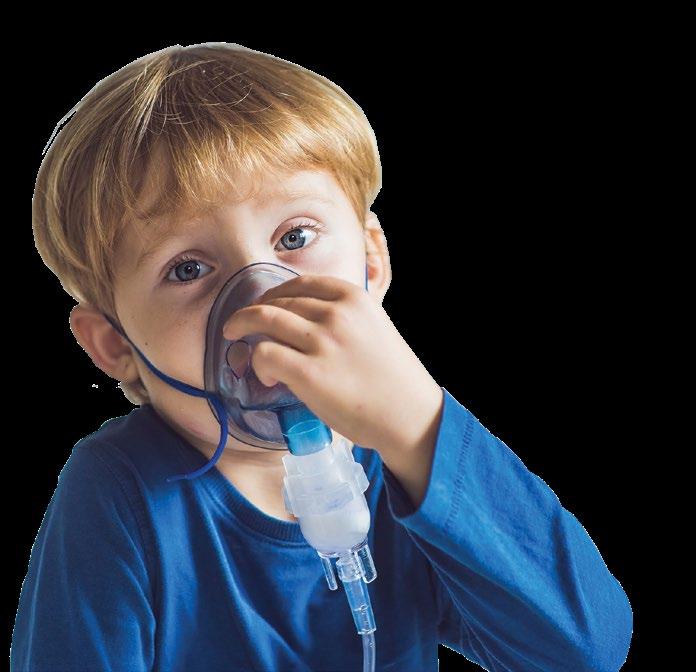
Dr Hedi van der Watt is a Paediatrician based in Claremont, Cape Town. She has a special interest taking care of preterm infants and newborns, mainly operating from Life Kingsbury Hospital’s Neonatal and Paediatric units. Her practice is not limited to neonatology alone, it also includes general paediatrics, ranging from paediatric dermatology, childhood asthma, feeding related difficulties, learning difficulties and adolescent health.
T +27 21 761 3408
E hedi.vanderwatt@gmail.com
W www.copperfieldchildcare.co.za
health
52 www.babysandbeyond.co.za

on Q&A
colic

Colic is a term used to describe severe, often fluctuating pain in the abdomen, particularly in infants. It is a common condition that affects babies, typically within the first few months of life. Colic is characterised by episodes of intense crying, fussiness, and irritability in an otherwise healthy and well-fed baby. Dr Allan S Puterman [MBCHB (UCT), FCP (paed), FAAAAI], Specialist Paediatrician, Life Kingsbury Hospital tells us more…
What is colic, how common is it, and how long does it usually last?

Babies with colic often have episodes of intense crying at least three times a week, usually in the late afternoon or evening, for no apparent reason. The crying can be intense and may be accompanied by excessive gas, bloating, and spit-up.
Colic typically begins around two to three weeks of age and tends to peak at around six weeks before gradually improving, and usually resolving by the age of three to four months.
Infantile colic is relatively common, affecting approximately 10% to 30% of infants worldwide.
Colic is more prevalent in first-born children and tends to occur equally among boys and girls. While the exact cause of infantile colic is unknown, factors such as gastrointestinal discomfort, immaturity of the digestive system, and heightened sensitivity to stimuli have been suggested as possible contributors.
It's important to note that although colic can be distressing for both infants and parents, it is a temporary condition that usually gets better on its own.
health
54 www.babysandbeyond.co.za
What causes colic?
The exact cause of colic is not fully understood, but there are several theories. Some potential factors include a combination of these factors:
• Gastrointestinal issues: One theory suggests that colic may be related to gastrointestinal discomfort or immaturity. It is thought that infants with colic may have an immature digestive system, leading to problems with digestion, gas, or abdominal pain.
• Immature nervous system: Some researchers believe that colic may be associated with an immature nervous system in infants. This immaturity could result in a heightened sensitivity to external stimuli and difficulties in self-regulation, leading to excessive crying.
• Overstimulation: Infants with colic may be more susceptible to overstimulation from their environment. Loud noises, bright lights, or changes in routine may overwhelm them and trigger crying episodes.
• Parental stress or anxiety: The emotional state of the parents can influence the baby's behavior. Some studies have suggested that colic may be more common in families with high levels of stress or anxiety. Stressful home environments may affect the infant's well-being and contribute to colic symptoms.
• Feeding issues: Problems with breastfeeding or bottle-feeding techniques, such as incorrect latching or swallowing excessive air
while feeding, can contribute to colic symptoms.
• Changes in the gut microbiome: The gut microbiome plays a crucial role in digestion and overall health. Alterations in the composition of the gut bacteria in infants have been associated with colic, suggesting a potential role of the microbiome in the development of colic symptoms.
• Food allergies or intolerances: In some cases, colic may be associated with food allergies or intolerances. Certain substances in a mother's diet, such as cow's milk proteins, may pass through breast milk and cause gastrointestinal symptoms in the baby.
There is no single definitive cause for colic, and it can vary from baby to baby.
Are there ways to lessen or prevent colic in babies?
Preventing colic is challenging as the exact cause is not well understood. However, there are some strategies that may help reduce the likelihood or severity of colic episodes. Here are a few suggestions:

Breastfeeding: If possible, try to breastfeed your baby exclusively for the first four months. Breast milk is easier to digest and may help prevent digestive issues that contribute to colic. Ensure that your baby is properly latched during breastfeeding or using the correct nipple size for bottle feeding to minimise the ingestion of air, which can contribute to colic symptoms.
Avoid smoking: If you or anyone in your household smokes, it's important to refrain from smoking around the baby. Exposure to secondhand smoke has been linked to an increased risk of colic.
Pacifiers: Some babies find comfort in sucking, so offering a pacifier can help soothe them and potentially reduce colic-related crying.
Formula selection: If you are formula feeding, talk to your pediatrician about the possibility of using a hypoallergenic formula. Some babies may have sensitivities or allergies to certain ingredients in regular formulas, which can contribute to colic symptoms.
Soothing techniques: Experiment with various soothing techniques to help calm your baby. Gentle rocking, swaddling, using white noise or soft music, and carrying your baby in a front carrier may provide comfort and help reduce crying.
Burping techniques: Make sure to burp your baby frequently during feedings. Burping helps release trapped air and can minimise discomfort that may contribute to colic.
Avoid overfeeding: Overfeeding can lead to digestive issues and exacerbate colic symptoms. Follow your baby's hunger cues and offer appropriate amounts of milk or formula.
Avoid overstimulation: Infants can become overwhelmed by too much stimulation, which can contribute to colic. Create a calm and quiet environment, limit exposure to loud noises or bright lights, and give your baby plenty of opportunities for rest.
Try a different feeding position: Some babies may benefit from different feeding positions. For example, you can try holding your baby in a more upright position during feedings to minimise air swallowing.
health
55 www.babysandbeyond.co.za
Is it better to breastfeed or bottle-feed babies with colic?
When it comes to feeding methods like breast or bottle feeding, there isn't a definitive answer as to which is best for infantile colic. The choice depends on various factors and may vary for each individual baby.

Breastfeeding has several potential benefits that could help with colic. Breast milk is easily digestible and contains antibodies, enzymes, and other components that support the baby's immune system and gut health. Some studies suggest that breastfed infants may have a reduced risk of colic compared to formula-fed infants.
However, bottle feeding, whether with expressed breast milk or formula, can also be a suitable option for infants with colic. It allows parents to better monitor the intake and assess any potential issues. Additionally, certain specialised formulas designed for colicky babies may be available, which can be worth considering if colic symptoms persist.
It's important to note, as mentioned, that the cause of colic is not fully understood, and it may not be solely related to feeding.
Win Win
Is colic painful for a baby?
While it is difficult to determine the subjective experience of pain in infants, it is generally believed that colicky babies experience discomfort and distress.
The crying episodes associated with colic can be intense and prolonged, often lasting for several hours a day, and may be accompanied by symptoms such as clenched fists, arched back, and difficulty in consoling the baby. This behavior suggests that the baby is experiencing some form of discomfort.
Is there medication for colic?

Yes, there are medications that can be used to manage the symptoms of colic. However, it's important to note that there is no specific cure for colic, and treatment options are mainly aimed at providing relief from the symptoms and supporting the overall well-being of the baby.
Medication for infantile colic is usually prescribed as a last resort when other measures, such as changes in feeding and soothing techniques, have not provided sufficient relief. The specific medications used can vary depending on the advice of a healthcare professional, as well as the individual circumstances of the baby.

If you have concerns about your baby's health or well-being, it's always recommended to consult with a healthcare professional for guidance and support.

56 www.babysandbeyond.co.za health
Includes Baby Bag and Baby Changing Unit valued at R1 260! Woodward’s Gripe Water Hampers STAND A CHANCE TO WIN 1 OF 4 To ENTER scan the QR code with your phone and complete the entry form online at www.babysandbeyond.co.za/competitions/ Closing date: 30 November 2023. T&Cs apply.
Scan me
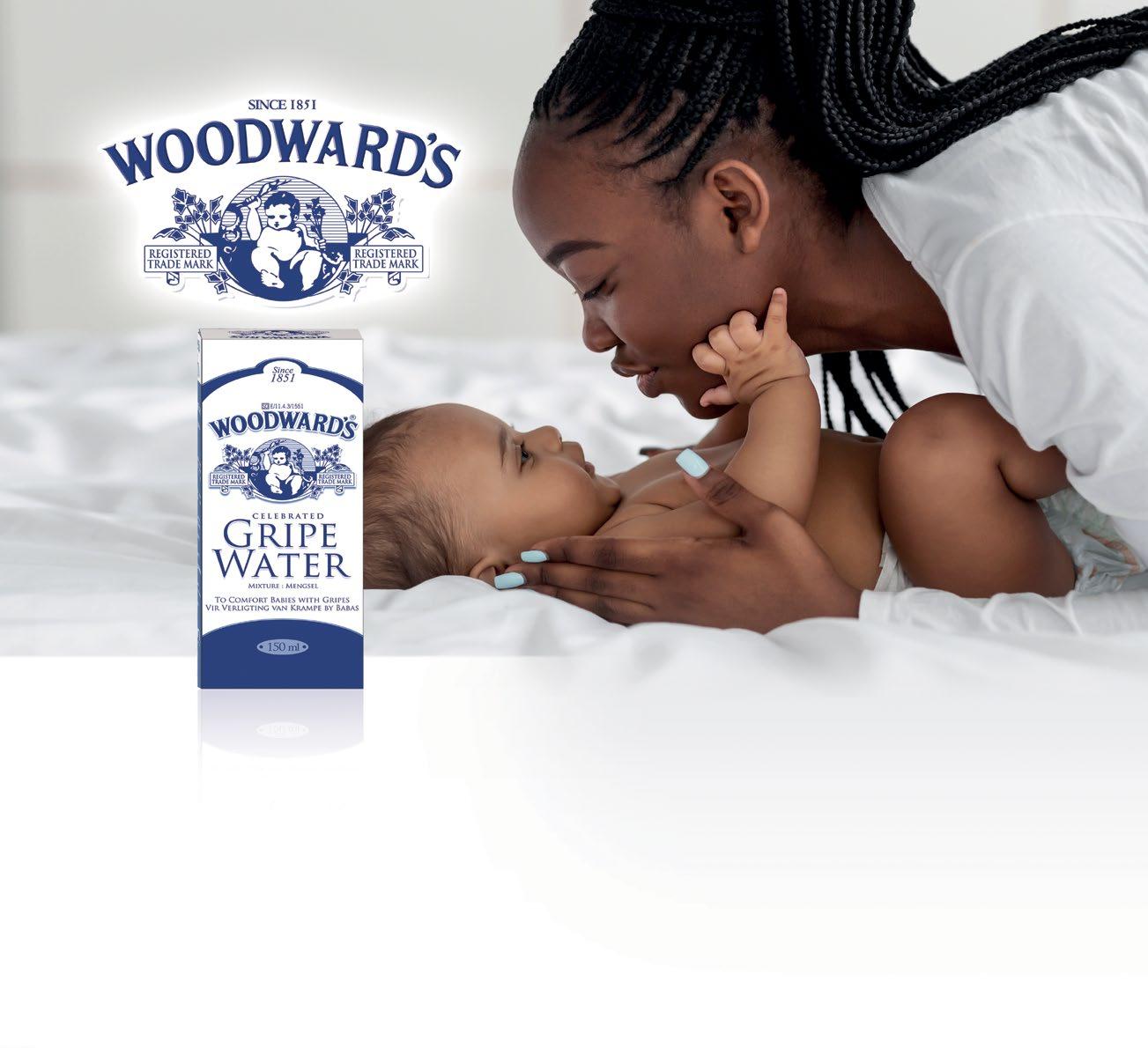











When it comes to soothing infants with gripes, there’s one name that generations of mothers have trusted. WOODWARD’S Celebrated Gripe Water
has been comforting
for over S0 WOODWARD’S Celebrated Gripe Water. Reg. No.: E/11.4.3/1551. Each 5 ml contains 50 mg sodium bicarbonate and 2,15 mg terpeneless dill seed oil. Trademarks are owned by or licensed to the Aspen Group of companies. © 2023 Aspen Group of companies or its licensor. All rights reserved. Marketed by Pharmacare Limited t/a Aspen Pharmacare Co. Reg. No.: 1898/000252/06. Healthcare Park, Woodlands Drive, Woodmead, 2191. ZAR-ZOSEAG-07-23-00002 08/2023 Marketed by Aspen Pharmacare www.aspenpharma.com Hotline 0800 122 912
160 years! WOODWARD'S
babies
Multiple Sclerosis:

New disease modifying treatments
Celebrities like actresses, Selma Blair and Christina Applegate, have been diagnosed with multiple sclerosis (MS) in recent years; placing the spotlight on this little-understood disease. So, what is MS, how does it affect South Africans, and what are the warning signs?
By Dr Natanya Fourie, Neurologist
MS one of the most common disabling neurological disorders in the world, severely impacts how people go about
their daily lives1 – especially among young adults. It can be a challenging disease to live with and is generally a unique experience with widely varying symptoms among patients.2
An estimated one in 700 South Africans have MS.3 But that number could be a considerable underestimation. These numbers aren’t accurate, because we don’t know what’s happening in the government sector. Diagnosis is missed there due to a couple of reasons, such as few resources, not many units with neurologists, and an initial belief that African patients don’t get MS.
Novartis South Africa, advocates for everyone to educate themselves about MS
To encourage potential MS patients to seek early diagnosis and treatment, a collaboration with leading healthcare company Novartis South Africa, advocates for all South Africans to educate themselves on some of the common signs and symptoms. Further education

among general practitioners and pharmacists is also required.
Often, patients will go to a pharmacist to say that they have numbness in their hands or feet, and the pharmacist will say to use a Vitamin B supplement. But MS can severely affect patients’ quality of life, which is why it’s important for more patients to obtain professional treatment as soon as possible.
If you cannot climb stairs and you work on a plant, for example, then you’re going to lose your job. If you can’t drive because you can’t feel the pedals, you can’t drive your kids. It has a major impact on all aspects of life – social and family life, and the ability to perform tasks.
health 58 www.babysandbeyond.co.za
Understanding MS red flags and risk factors
Because MS patients exhibit a variety of symptoms, it can be challenging to define this complex disorder accurately and concisely.
Typically, however, the onset of MS occurs around the age of 20 to 30 years, and the disease is more prevalent among women.4 Some environmental factors, such as an unhealthy diet, obesity, smoking, a Vitamin D deficiency, and the EpsteinBarr Virus (EBV), also known as the “human herpesvirus4”, can also play a role in heightening the risk of MS.5, 6
Signs and symptoms can include vision problems, either blind spots, blurry vision, or pain behind the eyes; new onset of motor weakness; weakness in the arm or the leg; sensory fallout; pins and needles; numbness, or waist-down sensory symptoms.
Occasionally, the diagnosis is missed, and we make a diagnosis at a later age. The problem then is that, most likely, there have been many relapses and the prognosis of getting somebody in remission or to prevent progression is worse.
There are several potential long-term complications or disabilities associated with advanced stages of MS.7 As multiple sclerosis advances, certain patients may experience a progressive decline in mobility, ranging from limited movement to complete immobility.7

If MS reaches more advanced stages, patients may develop a declining gait. Patients may need the use of a cane, walker, or wheelchair, and experience loss of bladder control and bowel problems. Hopefully, in today’s day and age, we don’t get people who become bedridden, but we have seen that in the past in the era when we didn’t have proper medication and the diagnosis was missed.
Living positively with an MS diagnosis
In good news for patients diagnosed with MS, there are a variety of modern treatment options and therapies available to effectively manage the disease.
Adopting a well-rounded diet, quitting smoking, and engaging in an appropriate exercise regimen, within the patient’s specific capabilities, can also be beneficial. Likewise, patients may wish to consult a psychologist, physiotherapist, or occupational therapist for support and guidance dependent on their unique needs.
References:
1. National Institute of Neurological Disorders and Strokes. Multiple Sclerosis. Available from: https://www. ninds.nih.gov/health-information/disorders/multiple-sclerosis#:~:text=Multiple%20sclerosis%20(MS)%20 is%20the,of%2020%20to%2040%20years [Accessed 15th June 2023]
2. IPInclusive. Living with multiple sclerosis – a personal account. Available from: https://ipinclusive.org.uk/ newsandfeatures/living-with-multiple-sclerosis-a-personal-account/ [Accessed 15th June 2023]
3. Modi G, Mochan A, Du Toit M, Stander I. Multiple sclerosis in South Africa. Available from: http://www. scielo.org.za/scielo.php?script=sci_arttext&pid=S0256-95742008000500024 [Accessed 15th June 2023]
4. McGinley MP, Goldschmidt CH, Rae-Grant AD. Diagnosis and treatment of multiple sclerosis: a review. Available from: https://pubmed.ncbi.nlm.nih.gov/33620411/ [Accessed 15th June 2023]
5. Multiple Sclerosis Trust. Obesity. Available from: https://mstrust.org.uk/a-z/obesity#:~:text=Obesity%20 can%20increase%20your%20risk,of%20MS%20towards%20increasing%20disability [Accessed 15th June 2023]
6. Zarghami A, Li Y, Claflin SB, Ven der Mei I, Taylor BV. Role of environmental factors in multiple sclerosis. Available from: https://pubmed.ncbi.nlm.nih.gov/34494502/ [Accessed 15th June 2023]
7. Bottaro A. Long-term effects of multiple sclerosis (MS). Available from: https://www.verywellhealth. com/long-term-effects-multiple-sclerosis-5205732#toc-long-term-complications [Accessed 15th June 2023]
Finally, there has never been a better time to live with this disease, and it’s possible to have a positive mindset following a diagnosis. We now have plenty of available treatments.
If your attitude isn’t in the right place, if you are scared of medication, if you don’t ask for help, if you’re not honest that you need perhaps an anti-depressant or for pain, then these people do worse. People who say it isn’t going to change me, I’m still the same person, and I’m going to fight this with my doctor or specialist, they are the ones who do well.

health
59 www.babysandbeyond.co.za
Occasionally, the diagnosis is missed, and we make a diagnosis at a later age.
Untreated high cholesterol
is a ticking timebomb

High cholesterol can be a ticking timebomb if it is not detected and treated with the right medicine and necessary lifestyle changes. A pharmacist explains the dangers of this chronic illness that can lead to heart attacks and strokes, and the importance of treatment adherence.
 By Medipost Pharmacy
By Medipost Pharmacy
any people do not realise they are at risk of high cholesterol because it usually has no symptoms until it has progressed to become more serious, and it is therefore important to have your cholesterol tested regularly,” says pharmacist Themba Muhlarhi of Medipost Pharmacy, South Africa’s first national courier pharmacy.

Cholesterol is a greasy, waxy substance our cells need for healthy functioning. Our livers produce some cholesterol, but when we eat trans fats and saturated fats from animal sources including eggs, meat and cheese, some people develop hyperlipidaemia, also known as high cholesterol.
“Some people may have a condition called familial hypercholesterolaemia, a genetic condition reducing the body’s ability to remove low-density lipoprotein (LDL), which is sometimes referred to as ‘bad’

cholesterol, even if the person is extremely careful with their diet,” he explains.
“Children too can have high cholesterol and should be tested particularly if there is a family risk. If one of your parents has the condition, your chance of inheriting it is 50/50. If you have familial hypercholesterolaemia, any of your children also have a one in two chance of being diagnosed.
“As we get older it is advisable for everyone to test more regularly, up to once a year from the age of 45 for men and from 55 for women,” he says.
health
“M
NORMAL ELEVATED HIGH VERY HIGH CHOLESTEROL 60 www.babysandbeyond.co.za
What is cholesterol?
Risk factors
Why is high cholesterol dangerous?
“Excess LDL cholesterol in our blood can become stuck together with calcium, minerals and other substances to form a plaque that lines the arteries. As well as narrowing the arteries, pieces of this plaque can break off and a blood clot could form in an attempt to heal the artery wall,” says Muhlarhi.
If the blood clot becomes so large that it restricts the blood flow or breaks off and lodges elsewhere in the body, it can be very serious and potentially fatal. This is what causes heart attacks and strokes, as well as chest pains known as angina.
Staying well
“When high cholesterol cannot be managed with diet, exercise and other lifestyle modifications, oral medication may be necessary in combination with a healthy lifestyle including a diet that is low in saturated and trans fats, with plenty of physical exercise. This can be an opportunity to substantially reduce your risk for associated life-threatening conditions,” says Muhlarhi.

Depending on whether or not a person has already developed cardiovascular disease or a co-existing condition such as diabetes, your treating doctor will prescribe medication to help improve the healthy balance of cholesterol in your body.

Medipost Pharmacy offers free delivery of prescribed chronic medication, including treatment for high cholesterol, diabetes and many other conditions, anywhere in South Africa. This service ensures patients can access their medicines easily and confidentially from their home or workplace, making it easier to adhere to a treatment plan.
“The most common medication prescribed for high cholesterol are statins. Check with your doctor or pharmacist for any potential drug interactions if you are on any other medications, for example many statins cannot be used with protease inhibitors, which are antiviral medicines. Patients on statins should also avoid grapefruit and grapefruit juice, which can interfere with some statins while creasing certain side effects,” explains Muhlarhi.
People registered with Medipost Pharmacy’s chronic medication delivery service or self-care medication online shop, shop.medipost.co.za, have free access to telephonic clinical advice from pharmacists and pharmacist’s assistants in their preferred official South African language for advice regarding dosage, possible side effects or interactions and other concerns relating to medication dispensed by Medipost Pharmacy.
“The seriousness of high cholesterol should not be underestimated, even when you are on medication, a significant part of the treatment involves reducing unhealthy foods while increasing exercise to give you the best possible chance of good long-term health,” Muhlarhi concludes.
www.medipost.co.za.

Family history Being overweight Smoking health
61 www.babysandbeyond.co.za
Usually more likely as we age
Pros of probiotics
A strong, healthy gut needs plenty of good bacteria to function optimally and probiotics can provide a boost when needed. A Mediclinic pharmacist explains how you can get the balance of your gut bacteria right.
By Mediclinic
robiotics occur naturally in the lining of the small and large intestine, the vagina, urethra and cervix in women and the urethra in men,” says Lize von Schlicht, a pharmacist at Mediclinic Panorama.
Antibiotics can disturb the healthy bacteria colonies that naturally inhabit our bodies and cause unwanted side effects such as diarrhoea or yeast infections, which is why doctors will often prescribe a probiotic to be taken with a course of antibiotics.
The benefits of probiotics
Probiotics are not only necessary for restoring good bacteria when taking antibiotics, however. They can also:
strengthen the immune system and improve the body’s natural defences against diseases; and
increase the absorption of various nutrients and other substances from the gut.
“In fact, any condition resulting in the disturbance of our natural intestinal flora can benefit from probiotics,” von Schlicht adds. Examples include infectious diarrhoea, Crohn’s disease and irritable bowel syndrome.
The
right probiotic for the job
When it comes to probiotics, there isn’t just one type that suits all.

“Probiotics comprise a whole lot of different strains and species, and each of these offer different health benefits,” von Schlicht explains.
Probiotics come in various different dosages and forms, the most common being tablets (chew or swallow), capsules and drops. The dose required depends on the condition being treated and requires a doctor or pharmacist’s input.

health
“P
62 www.babysandbeyond.co.za
The most common probiotic strains are:
Lactobacillus species Helps with overall digestion, nutrient absorption, relief from occasional cramping, gas and diarrhoea, promotes immune health and supports urinary tract and vaginal health in women.
Bifidobacterium species Helps with overall digestion and nutrient absorption, and provides relief from diarrhoea, particularly related to travelling.
Bacillus species Promotes overall digestion, relief from occasional constipation and promotes vaginal health in women.

Streptococcus species Promotes oral and immune health.
Live cultures
“Probiotics are live bacterial cultures, so taking probiotics and antibiotics at the same time should be avoided. It’s therefore best to take probiotics at least two hours before or two hours after taking antibiotics,” von Schlicht advises.
Storing probiotics correctly is also essential for keeping the bacterial cultures alive. Avoid heat and moisture and store probiotics in tablet or capsule form in a dry, cool area under 25°C. Certain types of probiotics –especially probiotics in liquid form – should be stored in the fridge between 2°C and 8°C. It’s best to check what your pharmacist recommends.
Get your daily dose
Probiotics can be taken as a daily supplement to boost your supplies of gut-healthy bacteria. Fermented foods like yoghurt, kefir, pickles, sauerkraut, tempeh and kombucha tea are also great natural sources of probiotics.
However, von Schlicht cautions that taking extra probiotics when your bacterial colonies are already sufficient and functioning can cause gas, bloating and discomfort. If you experience these symptoms when taking probiotics, lower the dose.
Mediclinic Prime offers a range of family friendly content that provides expert advice on health matters. Join Mediclinic Prime at www.mediclinic.co.za/mediclinicprime
health
Achieving healthy
weight
loss
crash diets and cutting out entire food groups; a Mediclinic dietitian talks about achieving your weight-loss goals and keep the extra kilos off once and for all.
Forget
By Mediclinic
There is no shortage of information on the topic of weight loss – but sometimes it can be hard to tell the difference between good advice, dubious claims and outright lies. A dietitian can help you personalise your weightloss journey to suit your needs and lifestyle, explains Lize Snyman, a dietitian at Mediclinic Kloof.


Health benefits of weight loss
Weight loss is not just about looking a certain way or fitting into your jeans; it’s also about addressing the ways that carrying extra weight affects your health – including your cardiovascular system, joints and digestive tract.
It can cause heartburn, chronic reflux and bladder incontinence, and even interfere with hormone production in children. “It affects the entire body,” warns Snyman.

health 64 www.babysandbeyond.co.za
How to achieve weight loss that lasts
One of the best things about working with a dietician is that you won’t just lose weight – you’ll find it easier to keep it off.
Targeted weight loss: A lot of the rapid weight loss you may achieve with off-the-shelf diets is because you’re losing muscle mass, rather than fat.
“We do proper fat-loss regimes and aim to help the patient lose tummy fat in particular,” says Snyman.
Personalised plan: Even more beneficial is the fact that the plan will be tailored specifically to meet your needs and lifestyle.
“A dietitian can take into account a patient’s likes and dislikes, activity level and whether they can be physically active or not,” she explains.
“We also take financial means into account, which will affect the products you add into the diet. And then, obviously, the medical background – someone who has gout, for example, shouldn’t have tomato seeds.”
Regular tweaks: Sustainable diets need to be adjusted every two to three weeks, based on your results. A dietitian will do that, whereas with an off-the-shelf diet, you must take what you get.
Accountability: It’s easy to lose motivation when it’s just you and your scale. “A dietitian is much more than just a diet machine,” says Snyman.
“You’re a personal coach, a training coach and an emotional support who will help your patient through life events.”
The surgical solution
Where diet and exercise alone aren’t enough to achieve weight loss, the patient may be a candidate for bariatric surgery –and it’s not as major as you may think.
“The field has developed quite substantially over the past five years and there are so many options for different needs,” says Snyman, who works closely with gastroenterologists.
These include non-surgical, endoscopic options that can be performed in the doctor’s rooms, such as a balloon procedure.
“A general surgeon can do it, or a gastroenterologist. They put you under light sedation and insert the balloon down your throat. After a three-day recovery period, you’re back at work.”
Having the balloon in your stomach physically inhibits your ability to eat as much, giving you the opportunity to adjust your diet and lifestyle. It could be there for as little as six months or up to a year, depending on how long you need.
Some balloons can be topped up if your results plateau. During this time, you’ll also work with a psychologist, dietitian, and biokineticist to help you adopt a healthy lifestyle that’s sustainable long after the balloon has been removed.
Weight loss is enormously subjective. If you want lasting results, speak to a Mediclinic dietitian to find what will work best for you.

www.mediclinic.co.za/mediclinicprime


We stock a variety of medical bracelets, DexD Smoo Low Carb diabetic friendly milkshakes, DexD Chewies for low sugars, a range of low carb, keto and diabetic-friendly foods, cold drinks, chocolates, sweets and much more.


health
www.diabeticaccessoriessa.com Diabetic Accessories SA diabetic_accessories_sa diabeticaccessoriessa@gmail.com
AT
DIABETIC ACCESSORIES SA, WE PROVIDE PEOPLE LIVING WITH DIABETES ACROSS SOUTH AFRICA WITH AMAZING ACCESSORIES TO FEEL BEAUTIFUL
Nourishing the brains
bodies of your school-age
While there is so much today that is trumpeted as ‘convenient and easy’, many parents feel overwhelmed by the complexities and stresses of modern life. Time is always too short. Family life is often frenetic; overloaded with arduous work, school, and social schedules. In the midst of all this turbulence, we’re striving to do the very best for our kids, including getting sufficient good food down their gullets every day.
Parents face a range of challenges when it comes to making sure their kids get the nutrition they need to support optimal physical and cognitive development. Many children are picky or fussy eaters. Loadshedding is constantly disrupting food preparation and family mealtimes.
Prioritising the time needed to commute through traffic to and from school and work, cuts into our family time, and we’re eating far more meals on the go. The world is awash in fast foods, convenience meals and nutrient-poor treats and snacks that our kids can easily grow to prefer over healthy home-cooked fare. High prices are narrowing the choices of food we can afford.
School-going children particularly vulnerable to impacts of poor diet

Vanessa Clarke, a registered dietitian and spokesperson for ADSA (Association for Dietetics in South Africa) says: “With the rise of convenience food and easy access to take-aways through home deliveries and drivethrough’s, it is becoming harder for parents to ensure children consume balanced meals.
“Unfortunately, convenience and fast-food meals are often short on servings of vegetables and fruit, low in fibre and protein while higher in saturated fat and salt. Children are also often powering through their school day on energy and sports drinks instead of prioritizing nutrient dense meals made from whole foods.”
While good nutrition is important at every age, school-going children are particularly vulnerable to the impacts of poor diet. Of course, healthy eating helps to grow strong bodies, muscles, bones and teeth, but it also affects brain development and cognitive performance, as well as mood. Balanced meals play a vital role in having a well-adjusted child who is better equipped to meet the demands of a busy school day.
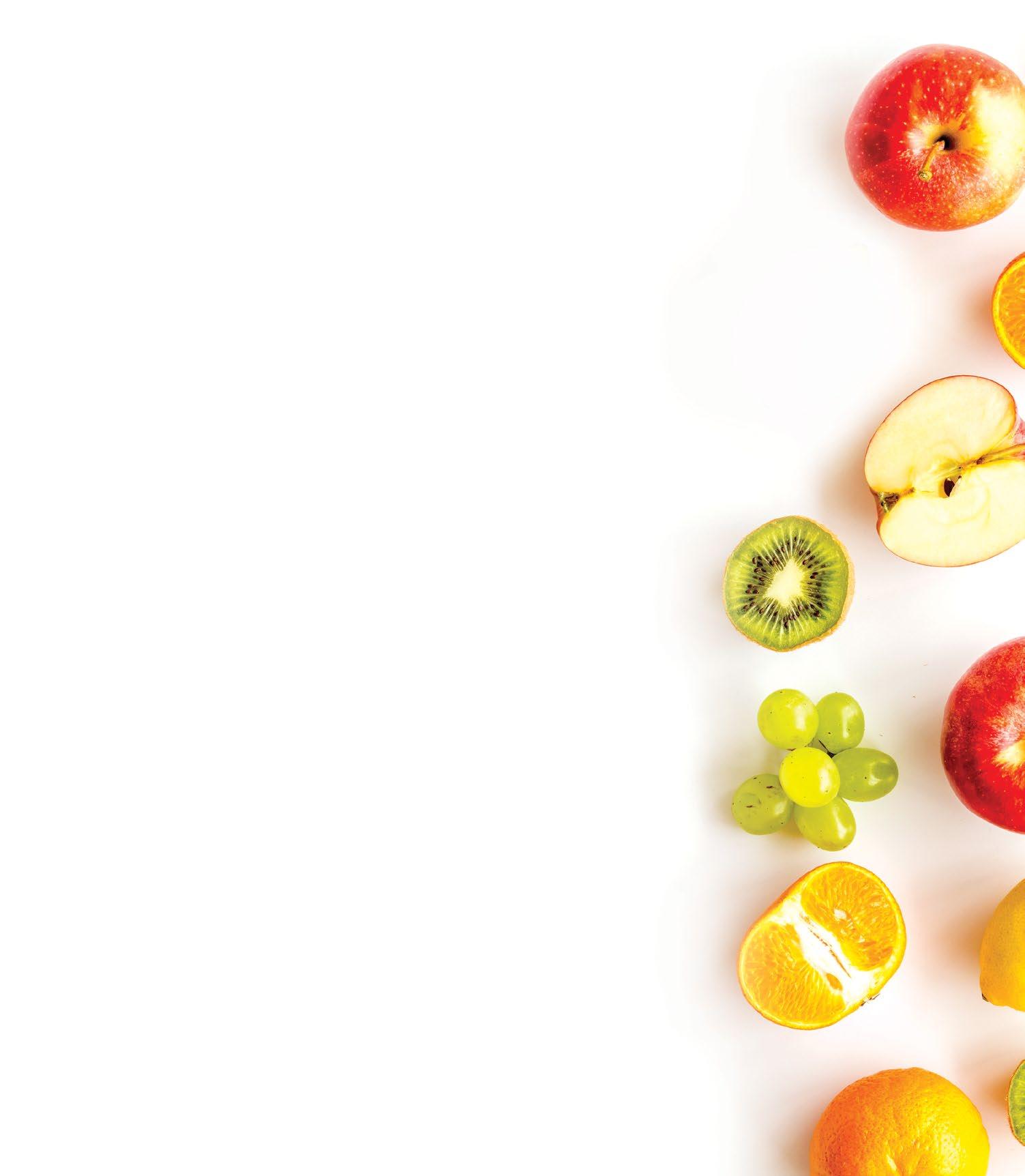
nutrition
66 www.babysandbeyond.co.za
and
Creating a family culture of healthy eating
As a parent of a school-going boy, Thembekile Dhlamini, another ADSA spokesperson and registered dietitian, is facing the same challenges as the parents she advises.
“I understand parents who are challenged by their children’s diet at home and at school because I am one of them,” she says.

“When my son started school, I would buy good sources of all nutrients to support his development, but he did not want any of the options that were given to him. His teacher noticed he was throwing away food from his packed lunch box.

“I had to shift my tactics. Now, I make sure that he eats home-cooked porridge or oats enriched with peanut butter before school, and I give him light lunchbox options such as fruit, yoghurt, nuts and water. After school, we sit together and eat a healthy home-cooked lunch with a variety of foods.
“As parents we must be role models for healthy eating and make a healthy lifestyle part of what we value as a family. We need to take our children’s preferences and habits into account, make sure they understand healthy eating and reinforce this at home to ensure that our children can perform well at school.”

Dietitians agree that involving children in meal preparation is a way to inspire healthy eating and can help make picky and fussy eaters more curious about trying a wider range of foods. Finding enjoyment and togetherness around making and sharing food as a family helps to build a culture of healthy eating and encourages learning about nutrition and the role of different nutrients in maintaining healthy bodies.
Essential nutrients for nourishing brains and bodies


“Supporting the energy demands of school going children is key. Just like adults, children require energy in three forms,” says Clarke.
“They need protein to support the everyday functions of the cells in their bodies, high fibre carbohydrates for a steady supply of glucose for their brains and bodies and healthy fat which supports brain health as well as helps children's bodies absorb crucial vitamins such as Vitamin A, D, E and K.
“Along with meeting children’s energy needs, adequate Calcium and Vitamin D intake is essential at school-going age, as 50% of a person's bone mass is acquired between the ages of 9 and 18 years.”

nutrition
67 www.babysandbeyond.co.za
Kid-friendly affordable nutrient-rich food options

• Yoghurt, cheese and milk provide both protein as well as calcium and essential vitamins.
• A peanut butter sandwich on wholewheat bread provides carbohydrates and healthy fats.

• A wholewheat sandwich with a filling of Omega-3 rich fish such as pilchards or mackerel provides carbohydrates, protein and healthy fats for brain function.
• Carrot and cucumber sticks with a hummus dip provides a highfibre, vitamin-rich serving of fresh veg as well as protein from the chickpeas.
• Eggs are a versatile food that can be included in lunchboxes and meals in many ways. In addition to protein, eggs provide iodine which plays a role in brain development and thyroid function.
• Beans in a wholewheat wrap or roll is a great way to provide both carbohydrate and protein at the same
time to school-going children.
• A banana before or after extra-curricular activities can help to boost energy.

• Water should always be the first choice to meet the fluids demands of a child. Add fruit such as strawberries, lemon or orange slices for extra flavour.
• For balance, always include fresh vegetables and fruits in lunchboxes. Add nuts, such as walnuts, if you can.


Planning, shopping and cooking in bulk
In a time of shrinking household budgets, rising food costs and a power crisis, many families are shifting to preparing extra food at dinnertime so that they have leftovers of a balanced, home-cooked meal for lunchboxes the next day.
“A bit of planning, shopping and cooking in bulk can help you to save on food costs and reduce your energy use,” Dhlamini concludes. “It also increases your family’s access to home-cooked meals and limits spending on nutrient-poor convenience or take-away foods. We all want to give our children the best start in life, and it is worth getting creative and smart when it comes to providing our kids with the balanced meals they need to thrive.”
nutrition
68 www.babysandbeyond.co.za
Looking for a healthy alternative to sugary drinks?





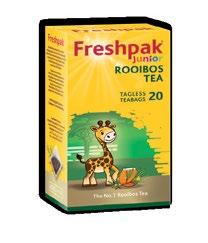

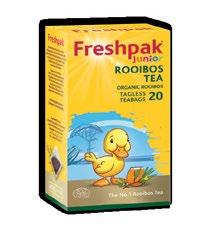
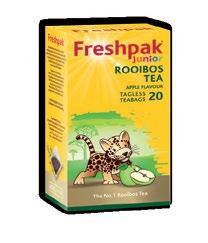

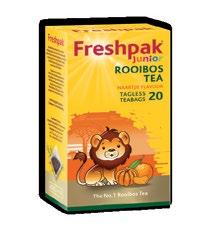


pour fun into
Freshpak Junior Rooibos Tea is specially formulated for kids, naturally caffeine free and a source of polyphenols, a beneficial antioxidant. Enjoy hot or as a refreshing iced tea. Perfect for kids at any time of the day. THE NO. ROOIBOS TEA FUN FRUITY FLAVOURS FUN FRUITY FLAVOURS THE NO. ROOIBOS TEA LL Scan for more refreshing recipes
Learning to live without your partner
Choosing to share your life with someone – from the everyday humdrum to the most defining moments – is for many people a fundamental aspect of being human. At the same time, the human experience inevitably involves loss, and the loss of a partner can be one of the most difficult heartaches to overcome.
 By Netcare Akeso Arcadia
By Netcare Akeso Arcadia
relationships
70 www.babysandbeyond.co.za
Dimakatso Motiang, a clinical psychologist at Netcare Akeso Arcadia in Pretoria, notes that grieving a relationship with a spouse or partner after a breakup or a death is a process that needs time, a willingness to embrace the emotional pain that comes with the loss, and a preparedness to share it with trusted others.

“Such a deep personal loss will bring on feelings of loneliness, grief, depression and anxiety, among others, and can result in physical symptoms including fatigue, headaches and even high blood pressure,
The stages of loss
Motiang notes that there are different stages of loss which can occur in no particular order, but that allowing yourself time to work through these stages as they present themselves is important to the grieving process.
“Very often it begins with denial about the reality of the situation where you may try to suppress the natural tide of emotions or to convince yourself that the relationship is not over and that your partner will come back to you. Denial can be a form of protection from the pain that will surely follow. When reality starts to sink in, you may become angry about the situation, seeing yourself as a victim and wondering why this has happened to you, which is another stage,” says Motiang.
“Then there is bargaining, where we try to make sense of events by retelling ourselves the story with those two fateful words – ‘what if’. What if I had done this, what if we had tried that? Sometimes we offer to make extreme changes to ourselves or the relationship as a way of bargaining to try to win back the lost loved one. The next stage of depression will bring with it feelings of sorrow, despair and hopelessness as you come to the realisation that you cannot change what has happened.
for example. This level of grief affects the way you see life and you can easily slip into a negative cycle of hopelessness and helplessness.
“Those who have been on the receiving end of a break-up will often feel a sense of rejection and inadequacy and might believe that they are undeserving of love. They may make changes in their life to try and live up to their perceived expectation of the partner who left them, chasing that elusive ‘perfect’ self in the hopes of regaining what they have lost,” says Motiang.
“In many cases, and especially when a partner has passed away, the person who is left behind can experience a range of emotions such as anger, abandonment, guilt and regret, and may get caught up in wondering what more they could have done to prevent their partner’s death or to enrich their life when they were still here. The emotional fallout after a suicide is particularly agonising and complex and should not be navigated in isolation. It feels, for most people, like more pain than they can emotionally and physically endure.”
“Finally, if you are able to enter the stage of acceptance, you can begin to move forward. The process of going through these stages can be frustrating. You may
move back and forth between them and wonder when it will be over, but quite simply – it takes as long as it takes, and it can take years in some cases,” she adds.
relationships
71 www.babysandbeyond.co.za
Human connection is key
According to Motiang, those trying to come to terms with the loss of their relationship will find the process more manageable if they reach out for support in counselling and their community, rather than trying to face the experience alone.

“Whatever the reason for the loss of your relationship, when you first lose a partner you are in a whirl of intense and conflicting emotions, and it is important to get help in untangling that. Counselling or therapy allows you to express yourself in a safe space and can help you to take a constructive approach to process what has happened. Conversely, bottling up your emotions can lead to isolation and can make it harder to maintain and grow other relationships in your life.
“Social interaction is key to getting through this difficult phase and you may need to push yourself to spend time with family, friends, co-workers and other members of your community, even if all you really want to do is stay at home under the duvet. Sustained human connection is what will help you to get into the rhythm of moving forward and letting go of your fears of how to continue living your life.”
Filling your own cup
“When your partner is gone from your life, even if they are still living but you are no longer together, it inevitably leaves a hole and it is natural to try and fill this space. Some individuals may rush to start a new relationship as quickly as possible, as the thought of being alone is overwhelming to them – these people have hardly spent any time being single. However, it is important to learn to fill your cup yourself and not to depend on others to do so.
“Give yourself a break to experience life for yourself. Try to do things alone – this could be doing the grocery shopping, enjoying your favourite meal, taking yourself on a solo date to trying something new. When you are happy and content in yourself, you are able to give love and start a new relationship with a full cup rather than coming from a place of desperation or co-dependency, which would not make for a healthy foundation.”
Forgive to move forward
Motiang explains that people often are not aware of the blame they place on themselves, and this can be a real barrier to moving forward in life.
“Sometimes you may not be aware of the blame you lay at your own feet, or you may have regrets that you did not do enough, and that you have missed the window for a second chance.
“Now is the time to reflect and acknowledge that perhaps at the time you did not have the capacity to give the relationship your all. Treat yourself with kindness – the situation has passed but you can learn from what occurred.
“Putting in the work to grow and move forward from this experience of loss is not easy and can take a very long time. It is important for family and friends to be supportive of this process rather than trying to rush you through it, as adding pressure into the mix will not help matters. We are all individuals and what may work for one person is not necessarily the answer for another.
“Knowing how to ask your loved ones for the support you need can go a long way to helping you navigate your way through this difficult time. If you simply want someone to sit and listen rather than give you advice, try asking for that. There will be good days and bad. You cannot control everything, but you can give yourself a second chance,” Motiang concludes.
relationships
72 www.babysandbeyond.co.za























5% Coupon 90 Day Returns Policy Free Delivery Baby Bank
a bundle of benefits
get when creating your registry through Babies R Us
REGISTER IN-STORE OR ONLINE TODAY! Includes a FREE Antenatal Course when you create a Gift Registry Scan here to create your Gift Registry
There’s
you’ll
PERFECT BABY SHOWER SPOILS
Coping with life’s curveballs –
There is no escaping change and its potential to impact our lives. Change can often be stressful and may require adjustment time. Various types of change can seem overwhelming but may also present valuable opportunities for personal growth. Netcare Akeso George offers eight tips to help make these transitions more bearable, positive experiences.


mental health
8 tips for adapting to change 74 www.babysandbeyond.co.za
“Whether you have been actively seeking change or it has been imposed upon you, there are unique challenges that come with different forms of change,” says Belinda Campher, an occupational therapist and general manager of Netcare Akeso George.

“Typical life changes may include pivotal transitions in a person’s work or studies, relationships, or family dynamics, moving home or relocating, loss of a loved one or significant health diagnoses. Change and the uncertainty it brings are part of life, and resisting change will not make it any easier.
“Change is normal and adjusting to it comes naturally to most people, however, major transitions may mean letting go of the life you are accustomed to and embracing a new one. If a transition is intensely challenging, it can destabilise our thoughts and emotions, leaving us feeling overwhelmed and distressed,” she says.
“Knowing how to cope with the curveballs life throws at you, is therefore a crucial life skill. Embracing change in a positive way helps us to become stronger and more resilient. Managing change in life is key to personal growth and enables you to live a life where you are thriving, rather than just surviving.”
Tips for coping with change

Understand and accept the limits of what you can control and what is beyond your control. Focus your energy and efforts constructively rather than becoming stuck in anger and denial.
Practise good self-care. Get plenty of sleep, eat a balanced diet, and feel the benefits of physical exercise.
Embrace healthy coping skills. Fun activities such as listening to music, spending time in nature, reading a good book or playing with a pet are good for your wellbeing, and can reduce your stress levels.
Cut out unhealthy coping skills. If you have been turning to activities or habits that do more harm than good, make a conscious effort to cut back.
Seek meaningful connections and support. Spend time with family and friends who are good for you.
Let go of your regrets. Regrets can hold you back in life. Looking back at the past may cause you to miss the opportunities change presents for the future.
Practise self-compassion. Treat yourself with the same kindness and compassion as you would a loved one going through a challenging time in their life.
The gift of gratitude. With reflection you may discover a greater appreciation for what you do have and what remains constant in your life during a period of change.
mental health
Change and the uncertainty it brings are part of life, and resisting change will not make it any easier.
75 www.babysandbeyond.co.za
mental health
Be proactive about how you manage change
“To create a life that we do not feel we need to escape from – a life worth living – we need to be proactive about how we manage the changes we face in our lives. However, sometimes, adjusting can be so daunting and overwhelming that it leads to an adjustment disorder,” says Campher.
“This may happen when the stress associated with change exceeds your resources for coping, and your reaction becomes disproportionate to the event. Consider seeking professional mental health support if you are struggling to cope with change.
“While the personal experience of adjustment to any change is unique, and may be expected to be uncomfortable initially, it may be cause for concern if the individual still feels overwhelmed three months or more later, or their suffering is disproportionate in response to the situation.
Talking to a mental health professional can be helpful

“Where a person is not coping in their day to day life, in their social relationships, at home, work, or school, talking to a mental health professional can be helpful in providing emotional support and learning to identify healthy coping mechanisms and stress management strategies.
“Seek proper treatment from a therapist or psychiatrist who can help you to manage the condition and learn the skills you need to cope with change and future life transitions,” Campher adds.
If you are having a difficult time coming to terms with change or experiencing emotional distress, Netcare Akeso’s 24-hour crisis line is always here for you on 0861 435 787. Trained counsellors are available to listen and can guide you on the various options for assistance, whether for yourself or a loved one.
Netcare Akeso operates a network of private inpatient mental health facilities and is part of the Netcare Group. Netcare Akeso provides individual, integrated and family oriented treatment in specialised inpatient treatment facilities, as well as certain outpatient services, for a range of psychiatric, psychological and substance use conditions. Please visit www.akeso.co.za or contact info@akeso.co.za for further information.

76 www.babysandbeyond.co.za




Skin-to-skin
Skin-to-skin contact is usually referred to as the practice where a baby is dried and laid directly on their mother's bare chest after birth, both of them covered in a warm blanket and left for at least an hour or until after their first feed.

 By Dr Judey Pretorius
By Dr Judey Pretorius
There is a growing body of evidence that skin-to-skin contact after birth helps babies and their mothers in many ways, such as enabling colonisation of the baby’s skin with the mother’s friendly bacteria, thus providing protection against infection and boosting the baby’s immunity.
What makes human skin so special?
The skin is the most seen and public organ, yet the least understood. A large array of chemical reactions takes place on a molecular and cellular level within the skin. Human skin is a complex living material but in biomechanical tests, it reveals its homogeneous nature.
Our environment can directly influence who we are. The skin reacts immediately and directly to the outside environment. The skin is colonised by a diverse milieu of microorganisms, most of which are harmless and some very beneficial to their host.
In utero, foetal skin is sterile, but colonisation occurs immediately after birth. Microbial communities of the skin and other sites are established and stabilised during the first years of life, especially with skin-to-skin contact with mommy or daddy as a newborn explores its environment and matures its immune system.
Environmental factors specific to the individual, including occupation, clothing, skincare regime, and antibiotic usage may regulate colonisation by the skin microbiota.
skin
78 www.babysandbeyond.co.za
The importance of products to sustain the effect of skin-to-skin contact
Mommy and baby care, hygiene, and skincare products are potential factors contributing to the variation of skin microbiota. For example, the use of products that are not pH-balanced will alter the conditions of the skin barrier and may either encourage healthy skin flora growth rates or cause it to deteriorate.


Can a product optimise your skin-to-skin contact with your baby?


Biomedical Emporium is a leading biotechnology company with expertise in dermatology formulation science. Its multi-award-winning brands have over time changed the way people see skin, as they continuously formulate dermatological products for skin that are as unique to the individual as their own fingerprint.

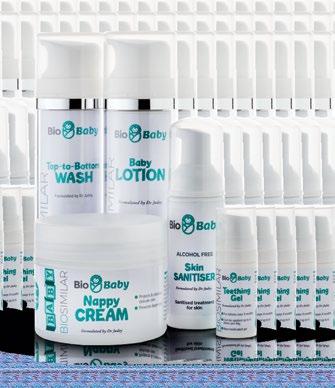

skin
Maternology range
The latest skincare series developed by Biomedical Emporium is the Maternology series for pre-conception and pregnancy, and the Biosimilar BioBaby range for babies.
During the process of trying to fall pregnant, IVF treatments, and pregnancy itself, it is important for a woman to change her skincare regime. This range will prepare mothers’ skin for skin-to-skin contact after the baby is born.
Many biochemical changes take place during pregnancy, emotionally, mentally, and physically. Pregnancy gives some fortunate women a beautiful glow due to the elevated hydration and skin moisture retention levels, along with the amplified exposure to vitamins and minerals via placental fluid transport.
Unfortunately, for other expecting mothers, the increased and fluctuating hormonal activity during the first
BioBaby range: Paediatric dermatology
The Biomedical Emporium BioBaby range was inspired by the pregnancy of the award-winning product formulator, Dr Judey Pretorius.
She has developed special care products for babies in the Biomedical Emporium laboratories that provide the necessary care for sensitive skin, boost immunity, and enhances skin biodiversity.

There are many postpartum skin problems that can occur in babies if they lack the necessary microbiota. One of these problems is seborrheic dermatitis, which is expressed as redness and flaking of the skin. It also causes severe itchiness and makes babies very uncomfortable.
This can be due to a lack of fully developed microbiota on the skin to protect them. For this reason, the BioBaby range was scientifically formulated with biosimilar microbiota to restore and balance the biodiversity of sensitive and compromised skin. The BioBaby range is free of allergens, irritants, phenoxyethanol, fragrances, dyes, and parabens. Products in the BioBaby range offer gentle care for atopic skin.

trimester can have the opposite effect, such as an increase in sebum production that may cause acne and pigmentation.
Skincare during pregnancy should be simple and easy as the skin is much more sensitive and reactive. The Maternology range is simplistic, easy, and safe to use. The ingredients are rich in vitamins and minerals and treat the skin optimally for pregnancy.
skin
80 www.babysandbeyond.co.za
Dr Judey Pretorius

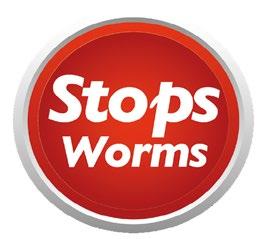
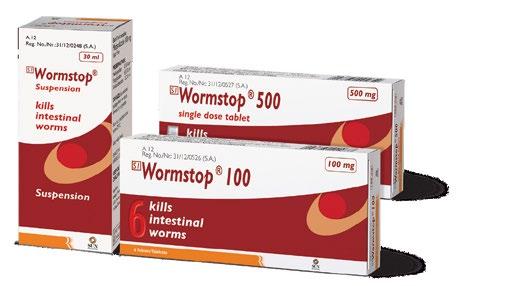
Mom said the grass needed mowing Dad said, yes dear - I’m going, I’m going But he ended up playing fetch with Spot And what a telling-off he got! *World Health Organisation. **Based on an infection rate in the community that is over 50 %. #Suitable for children from 2 years and above, not indicated for animals. References: 1. Wormstop® 100, Wormstop® 500, Wormstop® Suspension Package Insert. 2. Soil-transmitted helminth infections. World Health Organisation. [online]. https://www.who.int/news-room/fact-sheets/ detail/soil-transmitted-helminth-infections [Accessed 25 July 2019]. 3. SA Database of Medicine Prices - 26 April 2022. S1 Wormstop® Suspension. Reg. No.: 31/12/0248. Each 5 ml contains: Mebendazole 100 mg, Sugar Free. Preservatives: Methylparaben 0,18 % m/v, Propylparaben 0,02 % m/v, Sodium benzoate 0,2 % m/v. S1 Wormstop® 100. Reg. No.: 31/12/0526. Each tablet contains: Mebendazole 100 mg, Sugar Free, Artificially Sweetened. S1 Wormstop® 500. Reg. No.: 31/12/0527 Each tablet contains: Mebendazole 500 mg, Sugar Free Artificially Sweetened. Pharmacological Classification: A.12 Anthelmintics, Bilharzia medicines, Filaricides, etc. For full prescribing information refer to the package insert. Further information is available on request from the applicant. Marketed by: Ranbaxy Pharmaceuticals (Pty) Ltd., a Sun Pharma company. Reg. No.: 1993/003111/07. 14 Lautre Road, Stormill Ext. 1, Roodepoort, 1724, South Africa. Tel: + 27 (0)12 643 2000. Website: www.sunpharma.com Mom, it’s time to de-worm your family. Wormstop ® STOPS worms. 1 An effective and affordable treatment to eradicate most intestinal worms, suitable for the whole family.1,3# WHO* recommends de-worming twice a year.2** Ask your Pharmacist for Wormstop® today.
Skincare through the ages
When we look at skin, we all have this idea that “good genes” is the major contributor. However, we now know that it is more about the environment that you live in and your lifestyle.
By Karen Bester, Medical Trainer at Lamelle Research Laboratories
Only 10-20% of ageing relates to our genes. Considering this, looking after our skin thus becomes more important.

When do we start to look after our skin and protect it? We start to age as soon as we are born, thus it is important to start looking after your skin and protecting it as soon as you are born.


skin
82 www.babysandbeyond.co.za
Babies’ skin is resilient
Baby skin cells have optimal activity, making it resilient and when injured, will heal quickly.
Exposure to the sun is probably the most ageing factor within this lifestyle. We also live where the rainfall is low, so dry air will affect baby’s moisture levels in the skin.
What to use: Mild and safe moisturisers: after six months you need to apply sunscreen to sun-exposed skin if your baby is going to be outdoors or exposed to the sun.
Toddlers and young children: sun protection is important
Sun protection for toddlers and young children is important as they are often out in the sun more. In dryer areas, toddlers’ hands and faces can become dry and chapped. However, their skin is still very resilient and functions optimally.
What to use: A good idea is to apply sunscreen every day as they wake up in the morning. Most toddlers I know love being outdoors and they will get there regardless of doors being closed. In winter it might be a good idea to add some ceramides to help protect and repair their skin. Serra Body Lotion is a good product to consider here.
Pre-teens marks the start of skin issues
As a pre-teen, the body starts to change, and hormones become active. Some preteens might start to see that their skin is becoming slightly oilier, and they are getting blackheads and small pimples.

This is a good time to introduce a facial cleansing routine. Cleanse twice daily with a mild cleanser like Clarity Active Cleanse and apply a light moisturiser. I would suggest the Nourish Revitalise Lite. They can still use their sunscreen during the day but should apply a moisturiser at night. Good hydrating keeps the enzymes in the skin working well.
There is no data to support that facial scrubs have any positive effect on the skin. In most cases, the feeling of smoothness that you feel your skin is due to the addition of chemical exfoliators or enzymes that are added to scrubs. We would rather suggest a mild chemical exfoliation like the 2% salicylic acid that is in the Clarity Cleanser.
What to use: Sunscreen is still important and should be applied daily. Also effective is additional antioxidant protection in a moisturiser, or a mild chemical exfoliation if necessary.
Teens need a twice-daily routine of cleansing, moisturising
It is a good idea to get your teenager into a twice-daily routine of cleansing, moisturising and applying sunscreen in the morning.
How do you know if your child is at this state? When boys start growing hair under their arms or on their faces and girls start to menstruate is a good indicator.
If your child does not have acne, focus on a nourishing moisturiser
with antioxidants to protect their skin.
If your child is presenting with active acne, I suggest you make an appointment with a skincare therapist that can assist with a range of products that their skin needs.
What to use: Sunscreen daily, and antioxidant protection or an acne range depending on what their needs are.
Young adults need to protect what they have
In this phase of life protecting what you have becomes very important. A skincare routine that includes sunscreen every day and the application of potent antioxidants in a nourishing moisturising base is the way to go.
If you can add ingredients that find and fix DNA damage you have protection that will keep your skin young. At Lamelle this is the Nourish range of products.
What to use: Astaxanthin and Pycnogenol, sunscreens, DNA correcting photolyase.
Adults need to reactivate and protect
When you reach your adult years and some damage has crept in, it is time to reactivate while still protecting. Sunscreen and antioxidants never leave the routine. At Lamelle we suggest you add recombinant or stem cell-derived growth factors to your routine.
These specialised peptides reactivate the cells in the skin to restructure damage caused in the past. These are combined with Vitamins C and A, both of which we use in very active forms, as well as specialist hyaluronic acid molecules to create even more positive changes in the skin.
What to use: Sunscreens and more, growth factors, ascorbic acid (Vit C) retinoic acid ester (Vitamin A) HAFi fragments (hyaluronic acid)
Seniors – it’s not too late to start!
The question I am asked most from people in their 60s and older is: “Is it not too late to start?” My answer is always that it is never too late to start with a good skincare routine. Any change in routine, and any additional use of daily sunscreen will improve the skin. The skincare routines and ingredients we use will be the same for adults and seniors.
skin
83 www.babysandbeyond.co.za
affects your
skin How your cycle
As women, our bodies go through a lot every month. From ovulation to PMS and menstruating, it might sometimes feel like you’re on a rollercoaster ride. Our monthly cycle has an effect on just about every part of our body – physically, mentally, emotionally, and of course, our appearance.
By Dr Judey Pretorius
Your menstrual cycle has a major effect on the appearance of your skin and may be to blame for many of the skincare challenges you’re faced with every month. That’s because our hormones play a major role in skin health, and when hormones surge or fluctuate, it shows on your face.
While every woman’s cycle is unique to her, it’s worth examining a typical monthly cycle to understand how and why your skin might operate the way it does – and what you can do about it. It’s normal to experience ups and downs throughout the month, but with a targeted, good quality skincare regime and healthy lifestyle, it’s possible to enjoy healthy, great-looking skin throughout all stages of your cycle.

How hormones affect the skin

During a typical menstrual cycle, most women will experience bouts of dryness and oiliness. In general, skin becomes most “problematic” just before, and during one’s period. This is the time in which you may experience pesky hormone-related breakouts.
Oestrogen production may influence the skin’s texture and thickness and progesterone production plays a major part in the skin’s natural oil production. When these two hormones fluctuate, it has a direct impact on the skin.

skin
84 www.babysandbeyond.co.za
Your cycle days 1 – 6
Due to low hormone production in the first few days of your cycle, your skin may feel dry or somewhat sensitive. This may make lines and wrinkles more noticeable. Apply plenty of hydrating products to counteract dryness, especially products containing hydrating hyaluronic acid.
Try Biomedical Emporium HA Contour Masque, a rich formulation that helps increase the skin’s production of collagen and hyaluronic acid, reinstating the barrier integrity and providing long-lasting hydration. Skin is rejuvenated and the appearance of fine lines and wrinkles is reduced.
Your cycle days 7 – 11 (follicular phase) Oestrogen production increases and stimulates cell turnover. For many women, this is the time during which their skin looks and feels its best. This may be a good time to gently exfoliate the skin to prevent clogged pores and to include a vitamin C product in your regime to increase radiance.
Try Biomedical Emporium Skin Biotic C Cream, a nourishing moisturiser rich in vitamin C, that’s suitable even for sensitive skin.
Your cycle days 12 – 16 (ovulation)

Oestrogen peaks during ovulation, which may result in glowing skin, but you may also notice that your skin becomes a little oilier during this time. That’s because oestrogen and testosterone production slowly decreases, and the production of progesterone slowly increases.

If not managed, this may lead to the formation of breakouts. Now is a good time to follow a regime that encourages sebum control and to opt for oil-free formulas.

If your skin is prone to breaking out during this time, try Biomedical Emporium Anti-Acne Serum. Anti-inflammatory and anti-microbial, this calming serum helps soothe irritation, reduce pore size and decrease excess sebum production, leading to clearer skin.
Your cycle days 17 – 28 (luteal phase)
During the luteal phase, progesterone reaches its peak, resulting in the skin producing a lot more oil than usual. You may experience hormonal breakouts during this time. This is a good time to use detoxifying products that draw out impurities and products containing salicylic acid to decrease redness and help existing breakouts heal faster.
Biomedical Emporium’s Facial Cleanser is a fantastic cleanser to use all month as it contains spot-busting salicylic acid and deeply yet gently cleanses and provides light exfoliation without disturbing the skin’s barrier integrity.
Lifestyle tips
Regardless of your individual needs throughout your cycle, everyone’s skin will benefit from following a fresh, healthy diet, cutting back on sugar and caffeine and cutting out smoking. Drink plenty of water, get enough sleep, exercise regularly and follow good skin hygiene (that means washing your makeup off every night and stop touching your face!).
Your monthly cycle may affect your mood, your energy levels and the appearance of your skin. As your body prepares for possible conception leading up to your menstruation period, plenty of hormonal changes occur, leading to fluctuating levels of oestrogen, testosterone and progesterone. Understanding your cycle is essential, as it affords you the opportunity to better treat your skin at its various stages and address concerns with the right products and ingredients.
Find out more at www.biomedicalemporium.com

skin
85 www.babysandbeyond.co.za
ikes! Y ikes! Y scalp
My child has lice…

The last thing any parent wants is a lice infestation. Here’s how to treat lice when it occurs.
By Mediclinic
As Dr Katie Yazbek, a general practitioner at Mediclinic Bloemfontein, explains, lice are tiny, wingless blood-sucking parasites that are not always easy to see with the naked eye. They don’t care if your hair is squeaky clean or dirty, so rest assured that if your child has lice, it doesn’t suggest poor hygiene.
“Lice are the adult parasite and nits are the unhatched eggs that are usually easy to spot and cling firmly to the hair shaft,” Dr Yazbek adds.
Warning signs that your child has lice are an itchy scalp and inappropriate scratching, at first around the sides and the back of the scalp and later of the whole scalp.

“Examine their hair carefully in sections with a magnifying glass to identify the lice and nits,” Dr Yazbek says.
If the parasites are present, treat your child’s hair with an antiparasitic preparation that is left on the hair overnight and washed off the next morning.
“The treatment must be repeated after a week to kill any nits that were left behind and have subsequently hatched,” says Dr Yazbek.
“The nits must also be combed out with a very fine-toothed comb, section by section. Blow-drying and flat ironing your child’s hair also kills the lice and limits the extent of the infestation. All pillows, linen and personal items including clothing also need to be washed in hot water and ironed. After successful treatment, sprays and shampoos with special plant oils can prevent reinfestation.”
Lice are spread from infected humans by head-to-head contact, combs, brushes, hats and clothing. They can survive for short periods on fabric (about 48 hours) and for a few minutes on plastic objects.
Does your child have lice?
Look out for signs of:
• persistent itching;
• tiny but visible lice on the scalp, body, clothing or hair;

• lice eggs in the hair; and
• small red bumps on the scalp, neck and shoulders.
These parasites are also known to crawl from one child’s head to another if in very close proximity or direct contact.
To prevent your child from getting lice, make it clear they should never share combs, hats, hoodies, towels, pillows or bed linen with someone who may have lice. Ensure they don’t rest their head on upholstered furniture in public places and they should avoid sharing earphones and headphones.
“If your child has lice, do not send them to school until the infestation is controlled,” says Dr Yazbek.
Time to see a doctor?
Certain specifically formulated shampoos are effective at killing lice. But see your doctor if:
• anti-lice shampoo doesn’t kill the lice;
• you are pregnant; and
• scratching has caused abrasions or infections on the skin surface.
Mediclinic Prime offers a range of family friendly content that provides expert advice on health matters. To receive our monthly mailer full of easy-to-consume health updates, in addition to a range of other benefits, join Mediclinic Prime today at www.mediclinic.co.za/mediclinicprime
86 www.babysandbeyond.co.za
Actswithin
Suitable Try Lennon Glycerine Suppositories for expected relief within 15-30 minutes.

Acts within 15-30 minutes.
Suppositories are generally more convenient in children and in adults who find it difficult to swallow.


Lennon Glycerin Suppositories for Infants and Children is suitable for children under 6 years.

GLYCERIN SUPPOSITORIES Marketed by Aspen Pharmacare www.aspenpharma.com Hotline 0800 122 912 Trademarks are owned by or licensed to the Aspen Group of companies. © 2023 Aspen Group of companies or its licensor. All rights reserved. Marketed by Pharmacare Limited t/a Aspen Pharmacare. Co. Reg. No.: 1898/000252/06. Healthcare Park, Woodlands Drive, Woodmead, 2191. ZAR-GLY-02-23-00002 05/2023
for the whole family!
Lennon Glycerin Suppositories for Adults is suitable for adults and children over 6 years. 15 to 30minut e s S0 Lennon Glycerin Suppositories For Adults. Reg. No.: E/11.6/1495. Each suppository contains 2,14 g glycerin. S0 Lennon Glycerin Suppositories For Infants and Children. Reg. No.: E/11.6/1540. Each suppository contains1,12 g glycerin.
Choosing a
school
school for your child
Choosing the right school for your child is a momentous decision that will shape their educational journey and lay the foundation for their future success.

As parents, it is crucial to take a holistic view and consider the diverse needs, talents, and aspirations your child may have. Adam Rogers, Executive Head of Reddam House uMhlanga, offers sage advice to parents who are faced with a plethora of choices, opinions and a rapidly changing world.
Academic excellence and support: Look for a school that not only emphasises academic rigour but also offers robust support systems. Academic support units provide specialised assistance for students with learning barriers, ensuring every child has an equal opportunity to achieve their academic potential.
Holistic development: Consider a school that embraces a well-rounded approach to education. Look for institutions that provide equal exposure to a variety of disciplines, including sports, arts, and cultural activities. This fosters the development of diverse talents and allows students to explore their passions and interests beyond the confines of traditional academics.
education
1 2
88 www.babysandbeyond.co.za
Continuous development: Ensure that the school prioritises continuous professional development for its teaching staff. A commitment to ongoing training and exposure to international best practices ensures that educators are equipped with the latest tools and techniques to provide a highquality education.
Future-readiness: In today's rapidly evolving world, it is crucial to select a school that prepares students for the challenges of the future. Look for institutions that integrate technology into the curriculum, offer coding and robotics programmes, and prioritise 21st-Century skills such as critical thinking, creativity, and problem-solving.
7
Transition support: Assess how the school supports students during transitional phases, such as the move from primary to secondary school. A seamless transition, with familiar environments and established friendship bases, minimises stress and facilitates social integration.
Academic pathways: Consider the academic pathways offered by the school. Evaluate the curriculum and certification options to ensure they align with your child's future aspirations. For example, the Independent Examinations Board (IEB) system provides a solid foundation for university studies, both domestically and internationally.
Global opportunities: Look for schools that offer global exchange programmes or partnerships with international institutions. These initiatives provide valuable exposure to different cultures, perspectives, and educational systems, broadening your child's horizons and preparing them for a globally interconnected world.

9 8
Individualised attention: Consider the student-toteacher ratio and the level of individualised attention provided. Smaller class sizes and a personalised approach ensure that each child's unique needs are met, fostering optimal learning and growth.
Parent-school partnership: Establish an open and collaborative relationship with the school. A strong partnership between parents and educators fosters effective communication, shared goals, and support for your child's educational journey.
Choosing the right school for your child requires a comprehensive approach that encompasses academic excellence, holistic development, supportive environments, and forward-thinking programmes. By considering these essential aspects, you can confidently navigate the decision-making process, providing your child with an educational experience that nurtures their unique talents, sets the stage for lifelong success, and prepares them to thrive in an ever-changing world.
3 4 5 6 89 www.babysandbeyond.co.za
education
10
Ethos and values: Assess the school's ethos and values to ensure they align with your family's principles. Look for an institution that fosters positive role models, promotes inclusivity, and encourages a strong sense of community. A school where students learn the importance of giving back and embodying core values will contribute to their holistic growth.
Increased money stress
Three out of four South Africans feel money stress, more than last year, with particularly women admitting to the effects of financial stress at home and work and on their health.

These are some of the findings from DebtBusters’ second annual Money Stress Tracker, one of the largest surveys about how financial stress affects other aspects of South African’s lives. There were over 35 000 respondents to the online 2023 survey, conducted among a representative sample of South African consumers who are currently not in debt counselling.
Of the 78% of respondents who said they feel money-stress (up from 70% in 2022), 94% said it was impacting their home life, 78% their work life and 77% believed it was affecting their health; a clear indication that money stress results in other types of stress.
Short-term concerns continue to be the main reason for this stress. Half the respondents said running out of money before the month-end was their main worry. As one put it: “There’s more month than money.”
Unsustainable debt levels
Since 2022 there has been a 22% increase in people who are anxious about being able to make their monthly debt repayments. Overall, 70% of respondents spent more than 30% of after-tax income on debt repayment, but the survey found that those taking home more than R20 000 per month and over had the most debt repayment pressure. Sixty-two percent of the respondents taking home more than R20 000 had unsustainable debt levels. This income band is the backbone of South Africa’s middle-class population.
“We advise consumers not to use more than 30% of their take-home pay on
debt repayments. Sixty-two percent of respondents in the two highest income bands we surveyed are spending between 40% or more of their income to service debt. This is simply too much, especially in a high-interest, high-inflation environment,” says Benay Sager, Head of DebtBusters.
This year, interest rate increases featured for the first time as one the main contributors to money stress. The other top reasons were unexpected expenses, inflation and living costs, the impact of loadshedding, school fees and retirement.
While all respondents said the biggest money stress factor was running out of money before the end of the month, the next concern for people who were 55 or older was having enough to retire. People
between the ages of 25 and 44 were more worried about paying off debt.
In terms of income bands, those earning less than R5 000 a month were most stressed about paying debts and school fees. Those earning R35 000 or more, were the most concerned about interest rate increases.
“This indicates that the highest earners feel the impact of rising interest rates on their financial situation,” explains Sager.
Four out of five women suffer financial stress
Compared to 2022 both women and men are 10% to 15% more stressed about their finances, work life, home life and health. Four out of five female respondents said they suffered financial stress.
finance
90 www.babysandbeyond.co.za
“When finance goes out the front door, then love goes out the back door,” said one woman.
Psychotherapist and Transactional Analyst, Diane Salters, explains that there may be two reasons for a higher proportion of women than men reporting high stress levels.
“Firstly, women are often carrying more of the burden of family care and responsibility than men. Secondly, women are more likely to admit to feeling stressed than men and reach out for help. Social conditioning often stops men from admitting they need help.
“Worldwide, women are more likely to use health services and social programmes. This is good because it means that women are more likely to get and use any help available,” she adds.
The survey also showed that people who are younger and with lower incomes feel the most stressed and anxious about money, although stress levels in respondents aged between 45-54 showed a 23% increase compared to 2022.

To deal with money stress all age groups said they were cutting back on spending, a strategy that on average 44% of respondents have adopted. This year 38% said they were looking for a better job or higher pay, up nearly 50% on last year.
Embarrassment inhibits positive action
Younger consumers and those in the lower-income bands are more likely to be looking for a better-paying job. Younger consumers are also 1.5 times more likely to set a budget and stick to it.
When asked why they haven’t acted to relieve money stress, the majority of under 35s said they feel stuck or embarrassed. Those aged 45 and up say they don’t know who to trust or want more time to think. The survey found that less than 15% of people with unsustainable monthly debt repayments take any positive action.
“The tragedy here is the significant number of people who could benefit from debt counselling and other forms of debt management that are readily available and proven to work, but who don’t seek help because they’re frozen in indecision, embarrassed or don’t know who to trust,” says Sager.
finance
recipes
Tip: Whole fresh or frozen squid is preferable to frozen rings. Do not use any form of tenderizing product.
Calamari wrap
By Natasha Marais
Ingredients
For the calamari:
• 500g squid (3 x large), cleaned and turned inside out
• ½ cup f lour
• 2 heaped tablespoons Weber Karoo Chop Spice
• 1 litre sunflower oil
• salt flakes
For the green sauce:
• 1 cup Greek yoghurt
• 20g coriander leaves
• 1 clove garlic
• 1 green chilli
• squeeze of lime juice
• salt & pepper to taste
Method
To serve:
• wraps
• lettuce
• tomato
• onion
• avocado
4
1. Prepare the green sauce by placing all ingredients into a blender and blending until smooth. Set aside.
2. Once the squid has been cleaned, slice into 1-1.5cm rings. Beat the rings with the rough end of a meat tenderizer mallet until flat (but not broken).
3. Sprinkle with Weber Karoo Chop Spice directly onto the squid and mix by hand to incorporate.
4. Cover squid in flour and ensure all parts are covered. Shake off excess flour before adding to oil.
5. In a heavy based pot or pan, heat the oil to very hot. Add the squid to the oil and cook for approximately 1 minute per side, until lightly golden. Fry in small batches. Do not overcrowd the pan.
6. Remove from oil and place on kitchen towel. Season with salt flakes.
7. Build a wrap with lettuce, tomato, onion, avocado, the fried calamari and some green sauce.


92 www.babysandbeyond.co.za
@dinewithtasha
Mediterranean one-pot chicken & rice
By Mmule Ncongwane
4
Ingredients
• 4 chicken breast fillets, cubed
• 2 teaspoons garlic powder
• 2 teaspoons smoked paprika
• 2 teaspoons dried coriander leaves
• salt and pepper to taste
• 2 teaspoons olive oil
• 2 cups uncooked basmati rice
• 1 × 400g can chopped tomatoes
• 2 tablespoons tomato paste
• 2 teaspoons dried oregano
• 1 teaspoon sugar
• 1 teaspoon smoked chilli flakes (optional)
• 400ml chicken stock
• 2 cups baby spinach
• 150g cherry tomatoes, halved
• 100g sundried tomatoes, chopped
Method
1. Season the cubed chicken with garlic powder, smoked paprika, coriander leaves, and salt and pepper to taste.
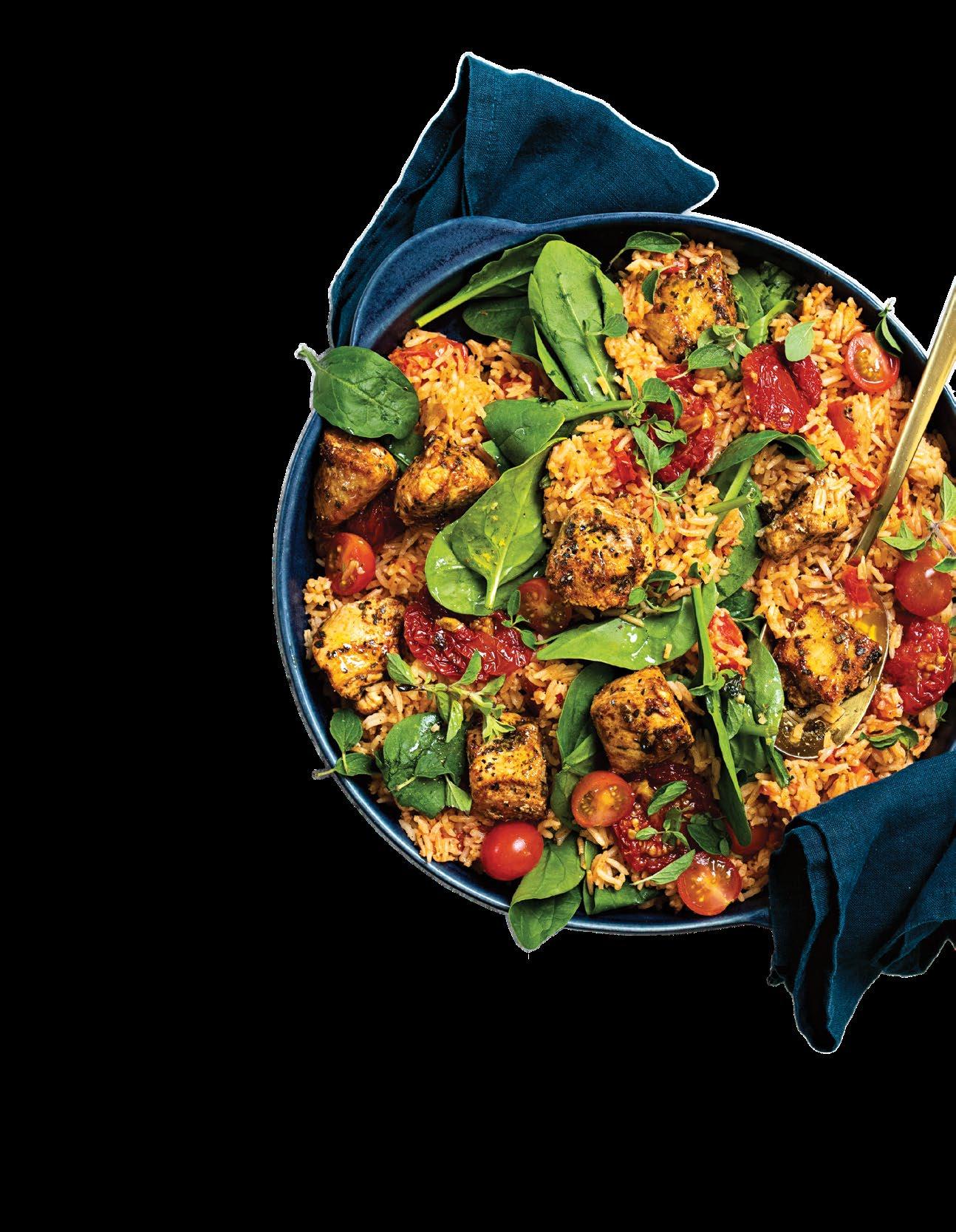
2. Heat the olive oil in a large pan over medium heat. Add the chicken and cook, stirring, until browned all over.
3. Add the rice to the chicken and stir in. Continue cooking over a medium heat for 5 minutes, stirring all the while to prevent the rice from sticking to the pan.
4. Add the chopped tomatoes, tomato paste, oregano, sugar, and chilli flakes (if using), and cook for 2 minutes.
5. Pour in the chicken stock, cover the pan and continue cooking until the rice is done (10-15 minutes).
6. Add the spinach, cherry tomatoes and sundried tomatoes and cook for a further 5 minutes until all the liquid is absorbed. Serve hot.
93 www.babysandbeyond.co.za
– Cape Point Vineyards
A world-class winery
by the sea
Cape Point Vineyards is a family-owned vineyard that is uniquely located in Noordhoek on the Cape Peninsula, set majestically against the slopes of the famous Chapman’s Peak mountain range and overlooking the nearby Atlantic Ocean – a mere 1.2km away.

Cool sea breezes along with ancient mountain soils make for a unique terroir with a late growing season that results in a world-class Sauvignon Blanc with minerals tones and great complexity.
Cape Point Vineyards has recently undergone major renovations, so be sure to book a table and join us at our new and improved venue!
Our restaurant
Cape Point Vineyards’ restaurant offers outdoor seating, sea and vineyard views, and a world-class a la carte menu by our Executive Chef, Chad Blows. Please note that bookings for 12+ guests requires a self-selected set menu with two options per course (excluding vegetarian options). With views of the children’s play area, you can enjoy your lunch while the children play.

Our picnics
Cape Point Vineyards is regularly cited as having one of the best vineyard picnic experiences in and around Cape Town.
Cape Point Vineyards invites you to spend the afternoon enjoying a relaxed picnic at our vineyard, accompanied by magnificent wines and breathtaking views.
Our picnics offer grass lawns for children to run around as well as a fun jungle gym for all ages.
The Courtyard
The Courtyard at Cape Point Vineyards offers laid back familyfriendly lunches. With a jungle gym for the kiddies to play on and panoramic ocean and mountain views for everyone to enjoy, join us for a glass of Cape Point Vineyards Sauvignon Blanc while you soak up the sun.

Cape Point Vineyards, Silvermine Road, Noordhoek
T +27 21 789 0900
E info@cape-point.com
advertorial
94 www.babysandbeyond.co.za
We also offer a delicious children’s menu available to children under the age of 13.
We invite you to spend the afternoon enjoying a relaxed picnic at our vineyard.

OurPicnicsetupincludes picnicblanketsandprism duringshapedpillowstobeusedyourstay:aperfectprop againstwhichtoreclineand soak in our sea, mountain and vineyardviews.

Not for Sale to Persons Under the Age of 18. Enjoy Responsibly

www.cpv.co.za
Painting with flowers flowers

Pocahontas’s secrets
Did you know the lotus flower was first used to represent the sun in Ancient Egyptian art and has since become a popular symbol of peace in yogic and health practices? During the Medieval and Renaissance period, painters and sculptures used flowers as an important motif to convey a certain meaning to audiences.


The oldest archaeological evidence of paint-making was found in the Blombos Cave in South Africa and was dated 100 000 years old! Paint made from plant oils was also an essential part of Native American storytelling, on cave walls and on the body. Pocahontas is well known for illustrating the deep connection these ancient tribes had with Mother Nature.

diy
96 www.babysandbeyond.co.za
Collecting your colours
The first ingredient you need is some flowers. Gather a colourful collection from the garden or pop down to your garden centre to choose from the huge selection of spring bloomers. Try to get a variety of different flowers as some are more pigment-rich than others, resulting in a brighter or more pastel colour. Try these colour-popping picks: daisies, fynbos, vygies, nemesias, petunia, dianthus, aquilegias, alyssum, and cornflowers.






Method

Remove the petals from your flowers and group similar colours together in the bowls.








...
... diy
Method
97 www.babysandbeyond.co.za
Step 2
Pour a splash of boiling water (just enough to cover the petals) inside the bowls. Using a paintbrush, mix the water-petal mixture (you should see the colour change immediately). Add more water if needed until you have a nice sloppy flower mash.
Step 3
Add a sprinkle of bicarb to one of the bowls as a tester. The alkaline pH from the bicarb will change the colour to a darker hue, which will continue to intensify if left for an hour or so. Now, you can play with both lighter and darker colours, yay!

Step 4
Use one of your other flower paint bowls for your second colourchanging experiment. Squeeze some lemon juice into a bowl with yellow/orange flowers. The acidity from the lemon will turn your paint into a vibrant, almost neon hue.


Step 5
Once you have all the colours of the wind, it’s time to paint with them! Got a white wall? Paint it! Got a gift card? Canvas? Cupboard door? Adorn them all! The flower paint can easily be wiped away with a wet cloth (or rain), so there are many potential places to paint on, apart from your paper.
Top décor indulgence
Get the kids to paint a series of floral masterpieces on A5 paper. Frame their artwork using contrasting frame colours or go for black to make the focal colours stand out. Hang their collection in the kitchen for all to admire!
Top tip for tiny tots
For younger kids who might (definitely) put their fingers in their mouths, it’s best to prepare guaranteed safe edible paint. You can do so by using the sap from squished berries and herbs, or from known edible flowers such as hibiscus, dandelions, lavender, honeysuckle, and nasturtium.

With so many flowers in bloom this time of year, the colour options are endless. This activity is perfect for independent play or as a fun family experiment. Help instil an appreciation of the natural world and a love for art. Life is a Garden, so paint passionately with yours!

98 www.babysandbeyond.co.za
diy
Detect possible hypertension at home and get accurate results thanks to OMRON’s Intelli Wrap Cuff technology.

There is feeling healthy, then there’s knowing.
Stimulate your brain with a classic game of Word Search!
f g e w h t e w s f c e w h u t y i p m
f a e q g h p a r t n e r g r e w h j y
a p o s t p a r t u m b g e c r o u p s
t b g e w g h t y i o p l k h z e w r s
h b t e s g h y u k j i l m o n e y o w
e g t e h h y k j n f r g h l d g h b d
r t y w e g g r t d f g e r e r e r i q
s a d v e n t u r e v n r e s w t y o h
n y j r w d r u i f p o k l t g t r t y
a v a p i n g h t i e r g d e r e t i g
j u t e o p h y r c n h r e r f d e c i
t y w e r s g h r i w r y u o n j u s e
t s r t r r e q f e v e r r l e q e z n
n l z s f e q e d n t r e g y u k l r e
b e e r t w r t w c d e q w a s g t e w
h e y t r o l t e y q s n e e z e e r b
j p g c o l i c r h j u k l c x e s z a
t w a h j f c w e r t q u i s c h o o l
o p y s t r e s s e d q e t y o o p h u
Win Win
adventure
cholesterol
colic
croup
deficiency
fathers
fever
flowers


hygiene
lice
money
partner
postpartum
probiotics
school sleep
sneeze
stressed
vaping
KRULKOP DRESS
One short sleeved christening dress valued at R450 up for grabs! Available in 0-3 months, 3-6 months or 6-12 months.

To ENTER scan the QR code with your phone and complete the entry form online at www.babysandbeyond.co.za/competitions/ Closing date: 30 November 2023. T&Cs apply.

word
search
SCAN NOW 100 www.babysandbeyond.co.za
STAND A CHANCE TO WIN A





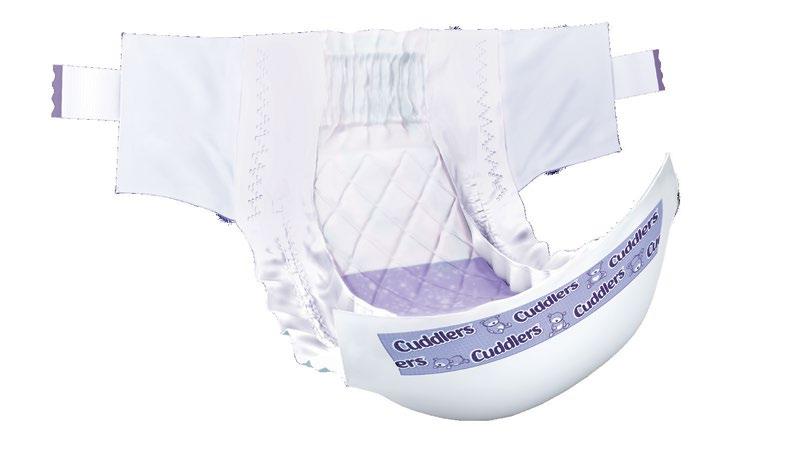
DID YOU KNOW
• Honey is the only food that is made by insects but eaten by both insects and humans.



• Natural honey contains flower pollen grains.


Explore and let your creativity shine with puzzles and pictures! kicks for kids
COLOURING FIND 10 DIFFERENCES Answer ? ? ?
adventure begin LET THE
? ?
102 www.babysandbeyond.co.za
DOT TO DOT




kicks for kids
MAZE

• Worker bees have a short life, no longer than 6 weeks. During its lifetime the bee produces twelfth of a teaspoon of honey.
• The queen bee lives up to 5 years. During the summer months a single queen bee lays 2 000 to 2 500 eggs a day.
TRACE LINE
?
DID YOU KNOW ?
? ?
?
103 www.babysandbeyond.co.za




CONTACT US: B&B Activities (PTY) Ltd | TEL. 021-879-5544 | EMAIL. orders@bandb.africa | www.blistex.co.za Tucks Half-page Ad_072023.indd 2 2023/07/21 10:30









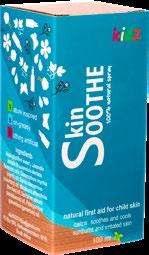


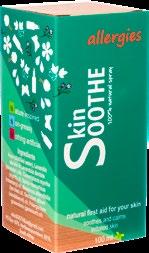








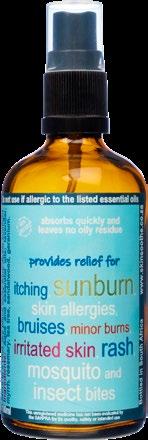









SCARS CAN FADE AWAY Clinically proven to reduce and fade old and new scars! FDA cleared for scar management Shop online: www.newgel.co.za Brought to you by NewGel+ is a Revolutionar y 100% medical grade silicone scar treatment range. Results can be seen within 3 months. S O U T H A F R I C A Caesar scar before NewGel+ After 3 weeks of NewGel+ Before NewGel+ After 2 months of NewGel+ After 4 months of NewGel+ Rated the No.1 silicone scar treatment by Plastic Surgeons in the USA available at www.skinSOOTHE.co.za ON-THE-GO SKIN SUPPORT





























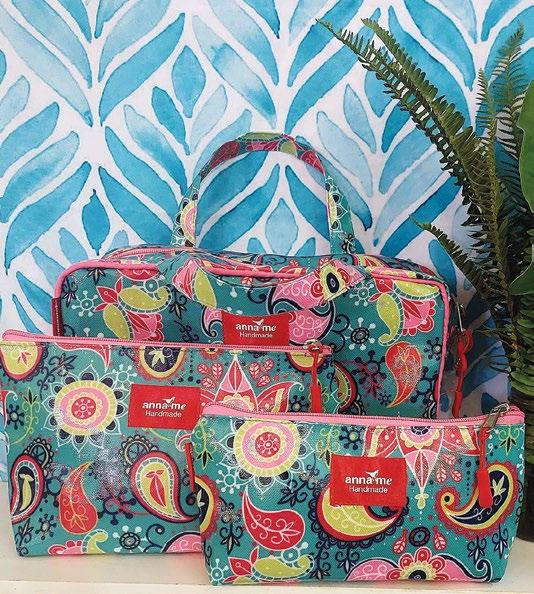


Stay in the Z ne with ... EPIZONE CREAMS AND OINTMENTS ARE... F R E E from harsh Ingredients Perfume and Colour F R E E Hypo-Allergenic Dermatologist Approved Suitable for A L L Ages & Skin Types Perfect Soap Subs�tute HOW TO USE EPIZONE E OINTMENT 1. Apply to skin area to be treated 2. Lather with luke warm water 3. Emulsify into creamy lather 4. Rinse off and pat dr y NO GREASY AFTER FEEL, JUST SOFT MOISTURIZED SKIN The I D E A L products to treat D RY S K I N condi�ons especially E C Z E M A Available from your nearest DISCHEM, BABYCITY, CLICKS & LOCAL PHARMACY A Proudly South African Product that streamline your life in the most elegant way www.annamehandmade.co.za info@annamehandmade.co.za 073 377 8626 Funky and practical bags






















W W W . S T I C K I T D E S I G N S . C O . Z A W A L L S T I C K E R S - S C H O O L L A B E L S - S T I C K E R S A N D S O M U C H M O R E . . .
We specialize in providing midwife care to woman with normal low risk pregnancies. The home away from home atmosphere has been created to provide women with an alternate place to birth their babies. The environment allows parents to feel comfortable and confident during the birth. We believe in normal active births where women can respond naturally to their bodies and make appropriate choices for their births We believe in freedom of movement and listening to your body during the birthing

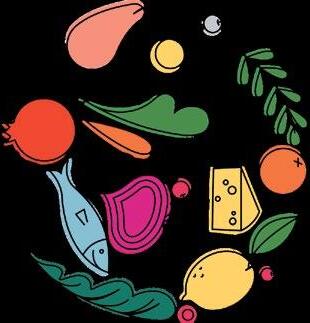






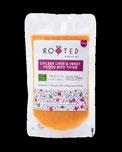











B I R T H I N G B I R T H I N G C E N T E R C E N T E R
YOUR HOME AWAY FROM HOME
011 835 1607 083 388 4424 birthing@stellarmed co za Stellarmed Medical Suites 53 Crownwood Road Ormonde W W W . S T E L L A R M E D . C O . Z A NATURAL NATURAL BIRTH BIRTH WATER WATER BIRTH BIRTH www.littlerabbit.co.za 082 332 1814 A4 or A3 print with your choice of animal, Ink pad, Wooden hanger frame Little rabbit & friends littlerabbit_friends LITTLE RABBIT & FRIENDS We treasure your memories forever
keepsakes MOTHERHOOD SHOULD BE ABOUT CONFIDENCE & CONVENIENCE Being a mellow mamma is about finding the serene strength within, embracing the ebb and flow of motherhood, and nurturing both your little one’s and your own tranquillity with a gentle heart. @MellowMammaSA +27 64 507 2145 info@mellowmamma.com ONLINE >> y TO YOUR DOOR r o o t e d n a t u r a @ r o o t e d n a t u f r o z e n m e a l s f o r t h e i n t r o d u c t i o n o f s o l i d s , t o d d l e r m e a l s & f i n g e r f o o d s e l o p e d b y a e s s i o n a l C h e f & i s t e r e d D i e t i t i a n r g a n i c i n g r e d i e n t s d e w i t h l o v e …
process
Footprint
My First Jan Braai Book
My First Jan Braai Book is the best introduction to braaing for little ones. It includes English, Afrikaans, isiXhosa, and isiZulu translations of basic braai terms, as well as picturebased steps to making South Africans’ favourite braai dishes, like chakalaka and roasted marshmallows. My First Jan Braai Book is a simple and fun way to get your kids into the spirit of the braai, perfect for braaiers of the future, and that friend of yours that struggles with the basics!

The Very Busy Spider’s Forest Friends
Join The Very Busy Spider and her forest friends in this touch-and-feel adventure!

Greet a new friend with each turn of the page as you explore the forest with The Very Busy Spider. The interactive text encourages young readers to feel and think about each texture they encounter, and Eric Carle's colourful art sets each delightful scene. Classic characters come to life in this sensational story – perfect for little hands!
How to Grow a Dragon
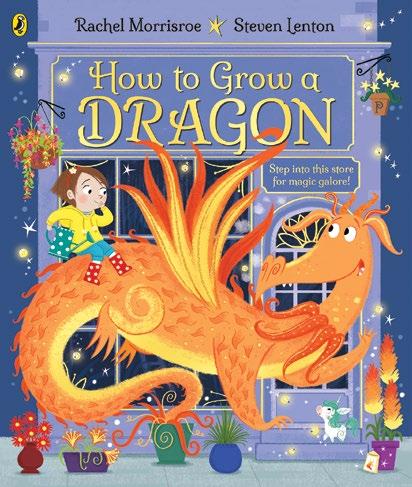
Join Sarah and Mr Pottifer in their magical plant shop, where fantastical creatures grow from trees. An unexpected delivery of dragodil seeds provides the perfect chance for Sarah and Mr Pottifer to grow helpful dragon pets for their customers – or does it? It turns out that these fiery dragons are not very well-behaved at all... and everything soon spirals into smokefilled, out-of-control dragon chaos! Can Sarah's quick thinking and green fingers save the day? This is the second magical adventure from the author and illustrator of the bestselling How to Grow a Unicorn
Ten Minutes to Bed: Bedtime Story Collection

A bedtime story collection of the Ten Minutes to Bed series, written specifically to help little ones settle down for bedtime. Featuring five wellloved stories from the Land of Nod:
Ten Minutes to Bed Little Dinosaur
Ten Minutes to Bed Little Dragon
Ten Minutes to Bed Little Fairy
Ten Minutes to Bed Little Unicorn
Ten Minutes to Bed Baby Unicorn
book reviews
110 www.babysandbeyond.co.za
Growing smarter each day!
Growing smarter each day!
The Smart-Kids Preschool range of activity books has been designed so that your little ones have tons of fun while learning. The books are bright, colourful and feature the creative Smart-Kids characters, bringing the worksheets and activities to life.
The Smart-Kids Preschool range of activity books has been designed so that your little ones have tons of fun while learning. The books are bright, colourful and feature the creative Smart-Kids characters, bringing the worksheets and activities to life.



Parents tell us that their children love Smart-Kids – it keeps their kids motivated and the activities are entertaining and interesting.
Parents tell us that their children love Smart-Kids – it keeps their kids motivated and the activities are entertaining and interesting.
PLUS we’ve added valuable tips and answers to make supporting your child as easy as possible.
PLUS we’ve added valuable tips and answers to make supporting your child as easy as possible.












Available in Afrikaans as
Available in Afrikaans as





Available at all good book stores and online retailers.
Available at all good book stores and online retailers.
For more info visit www.smart-kids.co.za
For more info visit www.smart-kids.co.za



Contact us
Contact us
T: 021 532 6000 E: info@mml.co.za
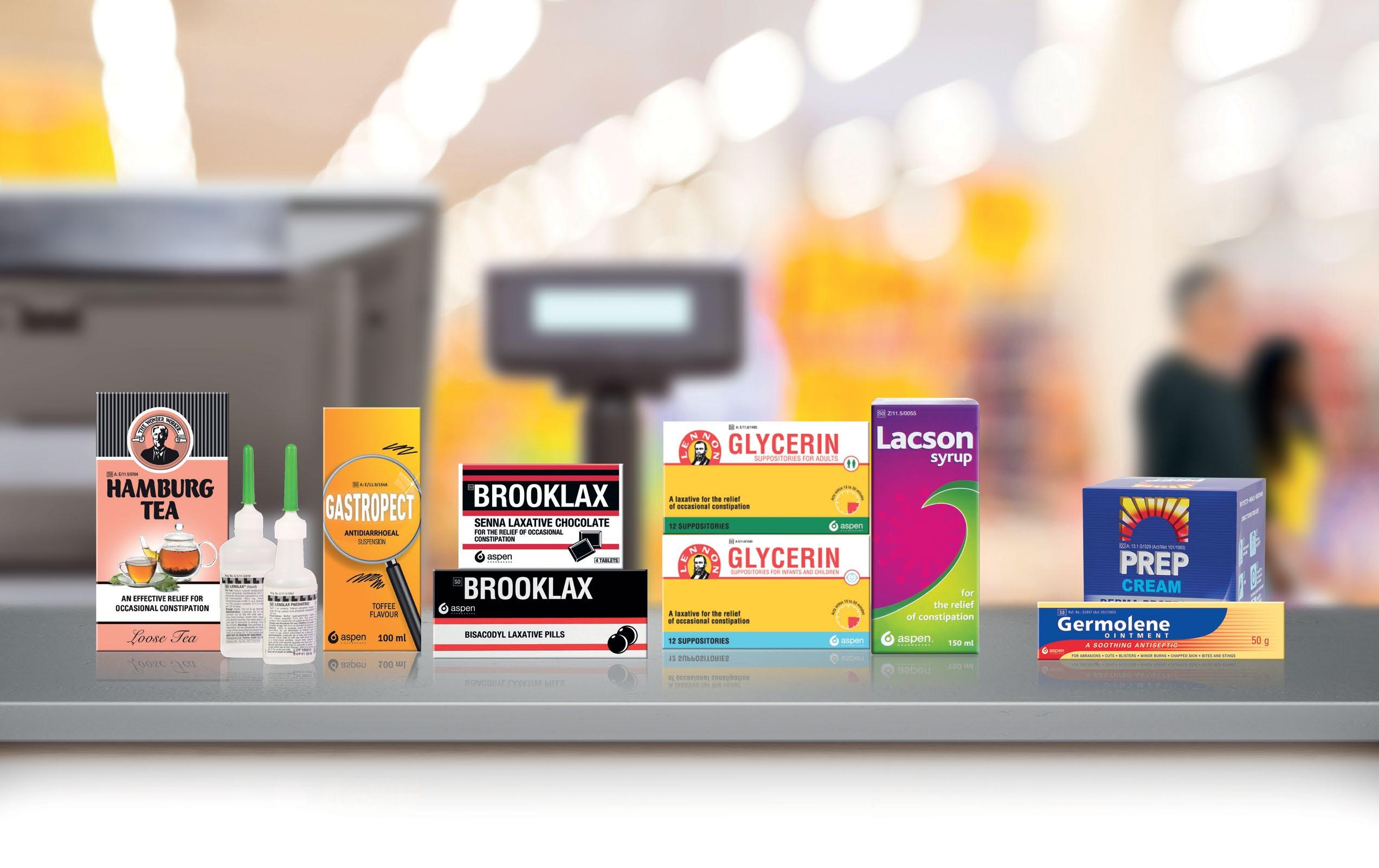
Aspen’s GIT Helping shoppers S0 BROOKLAX Senna Laxative Chocolate. Reg. No. 35/11.5/0168. Each chocolate tablet contains 30 mg Sennoside A and B as calcium salts. S0 BROOKLAX Bisacodyl Laxative Pills (Enteric-coated Tablets). Z/11.5/0055. Each 5 ml of syrup contains 3,3 g of lactulose. S0 GASTROPECT. Reg. No.: E/11.9/1546. Each 5 ml suspension contains light kaolin 1,00 g and pectin 0,05 g. S0 HAMBURG Tea. Reg. No.: E/11.5/0704. Each 550 mg contains 537,5 S0 LENOLAX (Enema). Reg. No.: E/11.5/819. Each 1 ml contains sodium dihydrogen phosphate dihydrate equivalent to 160 mg sodium dihydrogen phosphate monohydrate and disodium phosphate dodecahydrate equivalent to 60 mg disodium phosphate heptahydrate. S0 160 mg sodium dihydrogen phosphate monohydrate and disodium phosphate dodecahydrate equivalent to 60 mg disodium phosphate heptahydrate. S0 LENNON Glycerin Suppositories For Adults. Reg. No.: E/11.6/1495. Each suppository contains 2,14 g glycerin 1,12 g glycerin. S0 GERMOLENE Ointment. Ref. No.:G1847 (Act 101/1965). Each 100 g contains anhydrous lanolin 38,716 g, maize starch 7,840 g, zinc oxide 7,840 g, methyl salicylate 2,960 g, phenol 1,184 g, octaphonium chloride 0,300 g, menthol 213,0 mg, Menthol Levo 128,0 mg, Thymol 41,584 mg and Clove oil 0,042 ml. Trademarks are owned by or licensed to the Aspen Group of companies. © 2023 Aspen Group of companies or its licensor. All rights reserved. Marketed by Pharmacare Limited t/a Aspen Pharmacare

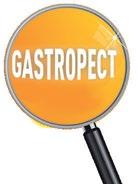

Marketed by Aspen Pharmacare www.aspenpharma.com Hotline 0800 122 912 & Derm Essentials find relief & restore regularity Tablets). Reg. No.: 36/11.5/0104. Each enteric-coated tablet contains Bisacodyl 5 mg. S0 LACSON. Reg. No.: 537,5 mg senna leaves which is equivalent to 13,4 mg, hydroxyanthracene glycosides as sennoside B. LENOLAX Paediatric (Enema). Reg. No.: E/11.5/1982. Each 1 ml contains sodium dihydrogen phosphate dihydrate equivalent to glycerin. S0 LENNON Glycerin Suppositories For Infants and Children. Reg. No.: E/11.6/1540. Each suppository contains menthol 0,012 g. S0 PREP Cream Ref. No.: G1529 (Act 101/1965). Each 100 g contains: Borax 1,043 g, Camphor 720,8 mg, Phenol Pharmacare Co. Reg. No.: 1898/000252/06. Healthcare Park, Woodlands Drive, Woodmead, 2191. ZAR-BIS-04-23-00004 04/2023




S0 BROOKLAX Senna Laxative Chocolate. Reg. No. 35/11.5/0168. Each chocolate tablet contains 30 mg Sennoside A and B as calcium salts. S0 BROOKLAX Bisacodyl Laxative Pills (Enteric-coated tablets). Reg. No.: 36/11.5/0104. Each enteric-coated tablet contains Bisacodyl 5 mg. ALSO AVAILABLE IN PILL FORMAT!




































































































































































































































































 By Drs Shah & Pretorius
By Drs Shah & Pretorius
























 By Mediclinic
By Mediclinic


 By Mediclinic
By Mediclinic





















































 By Dr Hedi van der Watt, Paediatrician, MBChB DCH FCP
By Dr Hedi van der Watt, Paediatrician, MBChB DCH FCP


























 By Medipost Pharmacy
By Medipost Pharmacy







































 By Netcare Akeso Arcadia
By Netcare Akeso Arcadia




































 By Dr Judey Pretorius
By Dr Judey Pretorius






































































































































































































